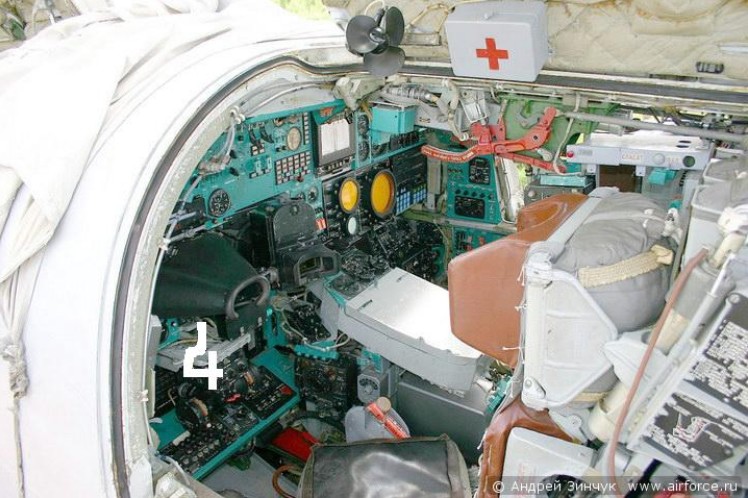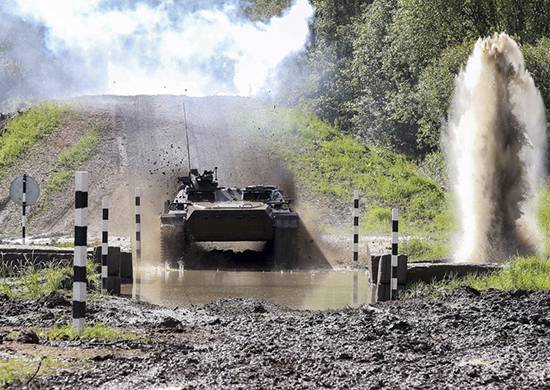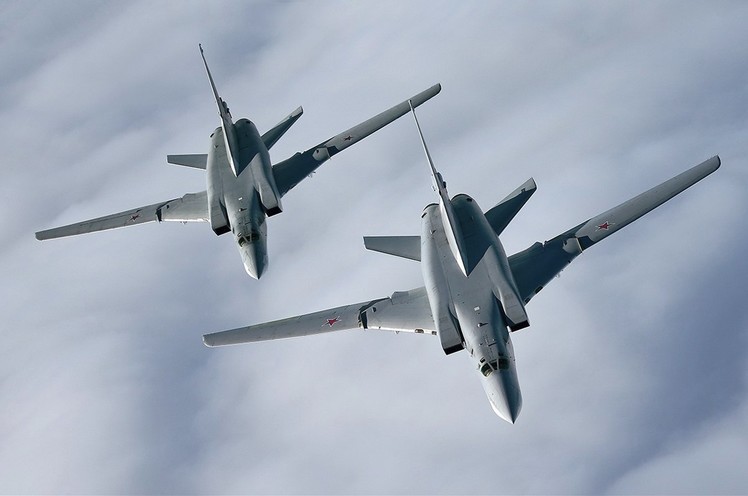
Tu-22M3 – long-range supersonic missile-bomber with variable geometry wings. It designed to engage supersonic guided missiles sea and ground targets by day and night, in any weather, also has the ability to cause bombing. Combat capabilities of the Tu-22M-3 allow you to perform combat missions to destroy the naval and ground targets in all range of conditions for its combat use in operational and strategic depth of the enemy defense when flying over the sea and the flat terrain.
Video Tu-22 in Syria
By the mid-1960s, the trend in the field of combat employment of long-range aviation identified poor performance single-mode supersonic heavy bomber. It was necessary to create a multi-mode aircraft, capable of performing combat missions in a wide range of altitudes and speeds. This objective could be achieved, Firstly, using a variable wing in flight sweep.
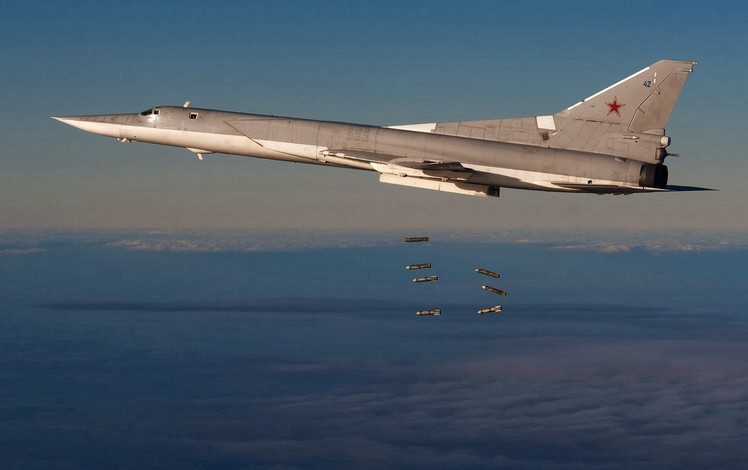
Work on the project of the further impact of the aircraft began in Tupolev in 1965 year. At first, work was carried out without funding from the state budget on the basis of initiative and marketed solely as a deep modernization of the Tu-22K. The project originally was called "Machine 145", or officially - machine "AM", «», and the final name of "article 45". At this stage of the design were design development, already tested on the aircraft Tu-22 with the placement of the engines above the fuselage on both sides of the keel. Alterations concerned almost exclusively wing aircraft of the future. However, to 1967 year on a number of technical reasons, the Tu-22M design has been completely revised, and a prototype of a new bomber aircraft lost resemblance to the predecessor. For a basis of the project "145" was finally taken by the project "106b". There is an option of the Tu-22M with a mid-wing, air intakes on the sides of the fuselage and engine placement in the caudal region, the type of heavy interceptor Tu-128.
28 November 1967 It issued a decree of the Soviet Government to establish a modification of the Tu-22K - Tu-22KM with engines NK-144-22 and variable sweep wing. This version of the design with some modifications became the basis for a future series of Tu-22M. This name emphasizes the continuity with the first supersonic heavy bomber Tu-22. In many ways, designation Tu-22M is the result of policy. A. n. Tupolev in the contest offers the option of modernization of the Tu-22 to save money on the development of the purpose of receiving the order.
Two basic variants of the aircraft have been worked. The first embodiment provided engines SC-144-22 (Products "FM"), navigation and flight control and aiming equipment on the Tu-22K. In the second embodiment provides engines SC-144-11 (product "PMA"), new and promising aircraft equipment. Also provided are two options in building a missile defense system - a traditional cannon with elements of the RAP or a more advanced set of REB due to the failure of the aft tower installation.
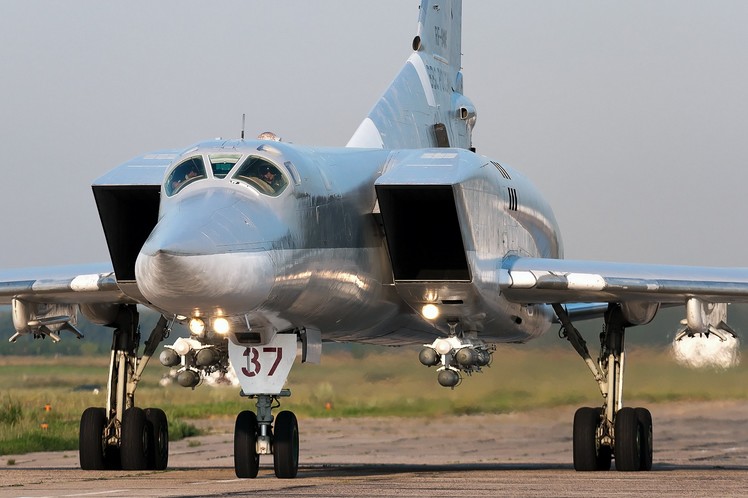
Design
Series aircraft Tu-22M - large and complex machines, gave numerous further developments both Passenger, and combat vehicles, all aviation KB USSR (aircraft 3-4th generation). Plane for the first time in the USSR was very difficult, but quite efficient as a set of interrelated digital, and analog decisive AO systems and EMR. A significant part of the airplane systems was built on the most modern at the time and based semiconductor integrated circuits, and as angular displacement sensors as the control surfaces, and setting devices in the cockpit instead of potentiometers and selsyns used sine-cosine transformers. It was on the Tu-22M large part of the crew of aircraft operations and the use of weapons was automated management, and "manual control" Jets system implies button presses or toggle switches in the cockpit in a predetermined sequence.
Series aircraft Tu-22M made by the normal aerodynamic scheme cantilever low (Besides 45-00) with variable sweep wing. The structure is made mainly of aluminum alloys V-95 and AK-8, as well as steel 30KhGSA, 30HGSNA and magnesium ML5-T4. The wing consists of a fixed part and the pivot arms. Wing permuted at angles from 20 ° to 65 °, (PCHK angle greater than the angle SCHK - rather rare design feature). Tu-22M2 sweep of 65 ° in flight is not applied. Mechanization of the wing slats comprises, trohsektsionnye double-slotted flaps, trëhsekcionnye interceptory (Tu-22M2 and the earlier series of Tu-22M3 used internal spoilers on SCHK as the landing of the air brakes), no ailerons. Differential spoilers operate in synchronism and the roll - as brake pads, while maintaining the lateral control function. Stabilizer - all-moving, synchronous (not more permissible fork 0,5 °). In case of refusal spoilers Stabilizer can operate differentially (after the start), preserving pitch control function, thus there are limitations on the roll and pitch control (landing flaps 23).
The aircraft has a fuselage semimonocoque and tricycle type retractable landing gear with nose strut. The power plant consists of 2 Turbofans NK-25, Tu-22M3 (originally used modified (multimode) NK-144, subsequently driven to modification NK-144-22 and SC-22). The fork Ustanovleno VSU TA-6A, with the starter-generator and a DC three-phase AC generator, and both the generator can operate on a network Jets (Unlike, for example, of Tu-154). Air intakes with vertical wedge (Tu-22M3 - Horizontal) located on each side of the fuselage. Margin "RT" fuel in an amount 53550 kg integral tanks located in front (sideburns 1, 2), secondary (3, 4, 5) and tail (sideburns 6, 7, 8) fuselage, in hernia (9-and tank) and wing tanks, a rotary portion including a wing (console). In the rear there are hardpoints 2 (sometimes 4) starting solid boosters.
At the insistence of the customer (Ministry of Defense) airplanes first series was the so-called middle pair of extendable undercarriage wheels, ostensibly for the possible use of the machine to the ground. Later on razdvizhki mechanism abandoned as a totally useless construction complications.
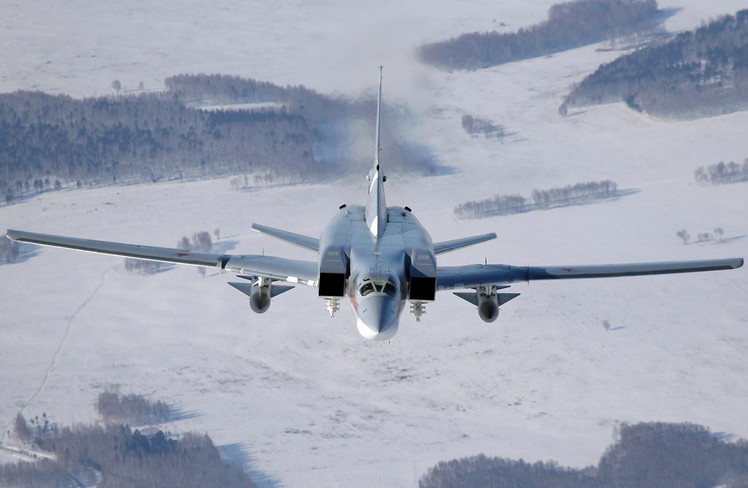
Fuselage
Fuselage - rectangular with rounded corners section (except for the bow and cockpit). It consists of a bow, includes nosecone (F-1) located before frame attachment № 1, and a pressurized cabin (F-2), between frames № 1-13, front portion between frames № 13-33 (F-3), the middle portion between frames № 33-60 (F-4), the tail section between frames № 60-82 (F-5), zadnego stekatelya. The compartments are joined to the fuselage frames planes № 1, 13, 33 and 82. The middle and the tail portion of the process connector and the fuselage are not constitute a single compartment.
Between frames № 33-44 in the middle part of the fuselage mounted wing center section, coupled with the fuselage in one piece. To the rear fuselage mounted keel and rudder and stabilizer. The framework and paneling of the fuselage is made mainly of aluminum alloys D16 and V95.
Right cover canopy pilots. In the open position, each cover is fixed by a special strut. To facilitate the weight of the lid mounted gas compensator, being charged with nitrogen
Nosecone leaking and consists of upper and lower portions. The top mounted instrumentation units PNA, at the bottom - its parabolic antenna. The bottom part is made of a radiotransparent material Cell (fiberglass) KAST-V.
F-pressurized cabin 2 - separate pressurized compartment, in the upper part there are jobs 4 crew, Equipment and machinery. The crew is in the ejection seats CT 1M. Approach to employment - through four cover access hatches, opened up. Under the cab floor is a technical compartment ("underground") with the equipment and unit control system, access to which is carried out through three germolyuka the bottom of the aircraft.
Unpressurized compartment F-3 frames with 13 by 33. The compartment is divided frame members for fuel cell № 1, compartment front chassis legs niche, compartment tank № 2, boats LAS-5M compartment, tehotsek "33 špangouta", Tank container № 1 Located between frames № 14-18, tank number 2 - between frames number 23-31. Bay front legs niche ("Horbatыy otsek") - the largest and rich technical equipment compartment of the aircraft.
gruzootseke. Main landing flaps open for access during maintenance
The middle part of the fuselage located between the frames number 33-60, number frames 48, 51, 54 and 60 gruzootseke are power. Structurally it consists of a tank-caisson 4K, podkessonnogo compartment, Tank container № 3, cargo compartment, tanks containers 5A and 5B, and the box-tank 5K. Caisson № is 4k power part of the wing (type center section) and used as a fuel tank (tank compartment negative accelerations). Gruzootseke reinforced longitudinal beams (ʙimsami) Alloy B95-T.
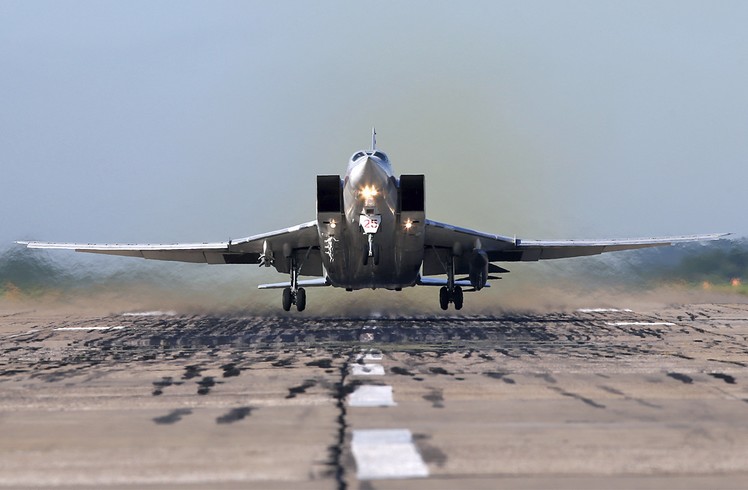
Due to the dimensions of a cruise missile X-22 high, than the cargo compartment of the aircraft, the latter is suspended in the fuselage holder in the semi-flush position. The nose of the missile is in part podkessonnoy 4K tank, the middle part of the rocket - in gruzootseke and tail of the rocket - in the space of the tank number podkessonnom 5, Why in the tank structure there is a niche for the keel rockets. For closing this aperture in the bottom of the fuselage of the aircraft axes by 34 to 65 frames are four pairs of independent flaps: front podkessonnye leaf number 1 and number 2, leaf gruzootseke, consisting of the main wings and hung on the front and back are movable wings and rear keel flap. The missile variant the front and rear doors open, basic sash gruzootseke are in the closed position, and the front and rear movable sash gruzootseke retracts into the fuselage, forming a niche for missiles. The mine and bomb option front and rear flaps are closed, and all three leaflets from each board gruzootseke mechanically connected to each other, forming a pair of single flaps, outward opening. In the rear of the machine may be installed gruzootseke clutter group protection APP-22MS, and pitching compartment 5 the tank can be installed two automatic clutter ASO-2B. The side walls and ceiling gruzootseke used to accommodate various equipment units and. Lower superstructure SCHK is a continuation of the lower air intake bypass (sub-channel compartments) and used as a technical compartment for accommodation units and units SLE, Birth Defects, radioblokov, and the left compartment - as "luggage", for transportation Jets property (pads, covers, etc.. d.) at perelёtah.
The rear part of the fuselage is located between frames № 60-82 and the middle part of the fuselage compartment-one. The aft fuselage located: APU on the upper fuselage panel forkil, between frames № 63-65, Channels engine air intakes, gas turbine turbofan engine, a drogue parachute container, caisson-tank number 5 between frames № 60-68 and soft tanks 6-7-8. Aft fuselage semimonocoque performed according to the scheme, having a longitudinal (stringer) set with stressed skin. The tanks are located between the engine and the air intake channels. The sub-channel of the technical compartments arranged with units of SLE and equipment engines and the airplane systems. Four spar bottom of the keel attached to the fuselage power the frames number 68,72,74 and 77. Forkil bound with the fuselage through the nodes in the intermediate frames and set square to the skin. In the tail portion of the keel located superstructure - in the top panel between the fuselage frames № 80-82 and a stabilizer, of shpangoutah № 74 and 77K.
The fuselage of the aircraft has a plurality of panels, hatches and hatches, intended for the access units and equipment of the aircraft for maintenance. Almost all the hatches and hatches are made easily removable, on the locks of different designs. Also, the plane is characterized by extensive use of color coding, Symbols with names, and numbers of circuit positions of all installed equipment, that the high-density placement of the latter greatly facilitates the technical operation.
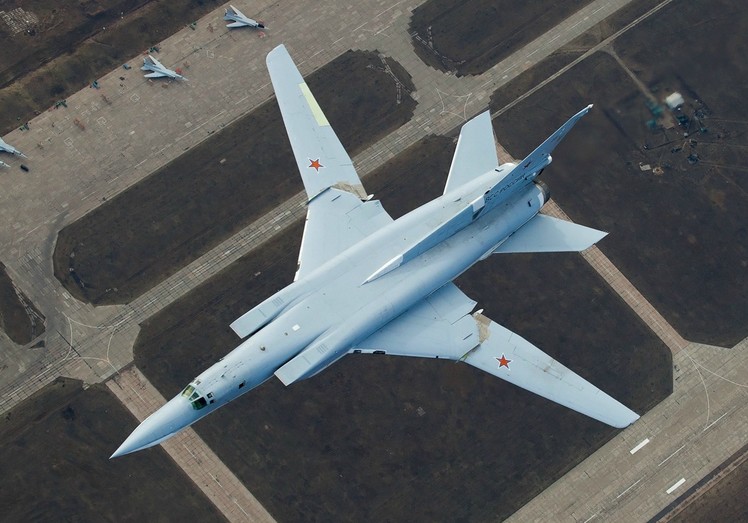
Wing
Wing technology consists of a rotary part PCHK, middle part SCHK, swivel, center section. SCHK center section and inseparably interconnected and together form a central part of the wing, Moreover, the center section is essentially Structures (and fuel tank compartment, negative overload, Tank number 4K). Carrying power of the center section, SCHK PCHK and are box-like structure, formed by longitudinal members, monolithic extruded panels and hermetically sealed at the ends of the ribs are the fuel tanks.
The middle part of the wing has a swept leading edge 56 °, and on the back - 0 °. Rotary Wing set during takeoff and landing position of the leading edge of X = 20 °, and only when this is possible sweep flap release (runway flap - 23 °, mounting - 40 ° or any intermediate - if necessary). PCHK at position 30 ° is used at subsonic speeds, of the flight in the terminal area to cruise. Sweep 30 ° up to 65 ° is used in transonic and supersonic. Flaps - double-slotted trohsektsionnye, with hydraulic screw drive motor from two-channel, installed on the ceiling gruzootseke. rotating wing control system is almost identical to flap control system (analogous to the Su-24), dual hydraulic motor is driven at the rear tons / compartment 33 špangouta. The control units PCS and PDS are set in the front compartment of the chassis recess. PCHK attached to pivoting hinge assemblies SCHK. Consoles have a negative conical geometric twist, makes an angle of -4 ° in order to prevent flow separation at high angles of attack and extend the operating range of flight speeds. Predkrыlki, mounted on the front edge PCHK and circuit synchronized with the flaps, automatically available mechanisms to the way electric flaps and removed automatically immediately after the full cleaning flap.
The hinge wing assembly provides angular displacement of the rotary part of the wing - PCHK relative to the middle portion of the wing SCHK, and also provides a fastening PCHK SCHK. This node takes all the loads, acting on PCHK: bend, torsion, shift. Besides the main purpose, the hinge assembly is an intermediate node for electrical wiring, hydraulic systems, transmission flaps, fuel drainage pipelines and.
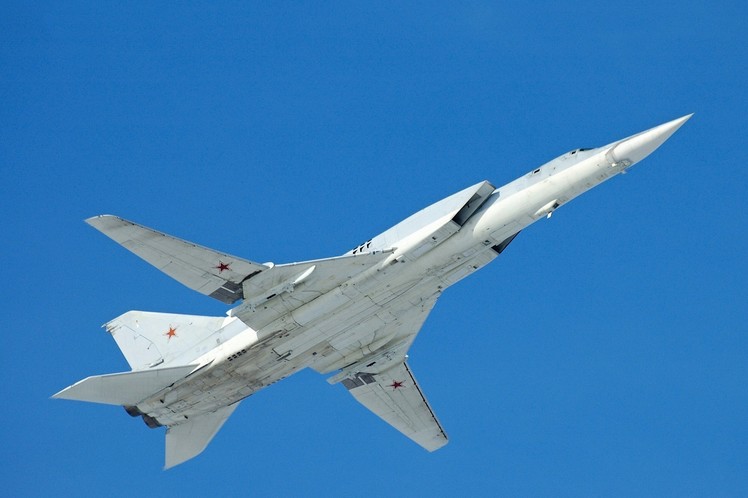
In view of the sad experience of the operation of the first TU-22, Where to use the ailerons with a mechanical wiring, and due to the heat occurred plating substantial deformation control rods, to the main control plane Tu-22M2 / 3 is applied on a roll-wire four-channel control system intertseptorami JUI-2M. The spoilers are mounted on each wing plane, moving blocks cylinders BGC-10, that, in its turn, controlled four-channel steering units RA-57, on the same three-channel design RA-56, standing on the Tu-154. The spoilers are used and how the brake flaps in flight and on landing, thus they can be synchronously released at any operating angle, vplot to the maximum deflection angle by stops in 45 °, and wherein the stored deviation of the differential to control aircraft roll. Use of spoilers instead reduces aileron "zakruchivaemost" wing with a M 1 and constructively relieve the trailing edge flap for installation of high-performance large-area.
Plumage
Stabilizer caisson structure with two side members, arrow-shaped in plan - a sweep angle of the leading edge 59 degrees and a transverse V = +8 degrees. It consists of two halves, mounted on the left and right side of the fuselage supports, which are connected by the differential mixer, which provides work as a stabilizer in the main steering mode height, and in standby mode the aileron. stabilizer halves have a profile on the back lifting force. The two halves are completely similar constructive, but the "lead", from which work equipment and on which all the measurements of angular movements, It is considered to be the right half.
On the plane to provide directional stability at high speeds is used developed keel, structurally consists of an upper part, lower part, forkil, the superstructure of the keel and rudder. The latter has a weight rebalancing and axial aerodynamic compensation 25 % its area. The lower part the keel is a caisson-tank № 9. forkil, besides improving directional stability, It serves to accommodate a variety of equipment, units and electronic units, including APU TA-6A. The aft part of the keel is made up of the upper fairing camcorder telepritsela TP-1km, average radiotransparent (fiberglass) radar radome "Krypton" and lower aft fairing installation Unified (UKU) with cannon GS-23M.
A characteristic design feature of the Tu-22M is shifted to the left on 2-3 degrees "zero" rudder, compensation for engine torque.
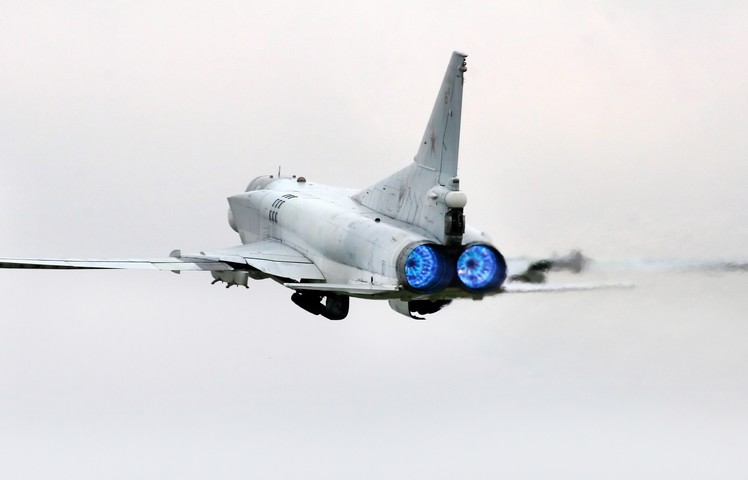
aircraft control system
dual control system, elektrogidromehanicheskaya, differential, four-channel control: the rate - rudder, after start - interceptory, Pitch - a stabilizer and a backup channel difstabilizatora (differential stabilizer roll).
Moving pilots column and pedal through mechanical linkage tubular transmitted through differential rocking on the power steering hydraulic actuator (boosters), which synchronously deflect half of the stabilizer and the rudder. Also connected to the differential rocking steering units AFCS-145m, which depending on the automation control signals are added (or reduce) deflection control surfaces, depending on the flight modes, or take over the management of the whole - in fact, all movements are tracked pilots, and if necessary,, adjusted automatic hard enough. Due to the almost complete lack of effort on the column and pedals to control the wiring introduced Flight / takeoff and landing load simulator - spring zagruzhateli. The pitch channel has an electromechanical automatic stop column flow - torsion. In the roll channel set-wire four-channel control system (EDSU), without manual wiring, two steering actuator that controls the power of hydraulic drives spoilers. For its reservation applies roll channel regulator with its steering unit, allows you to control aircraft roll differential deflection of the stabilizer halves. The wiring for the course management, roll and pitch trim are also installed electrical actuators (trimmer effect, channel pitch - avtotrimmirovaniya), electrical systems and automatic balancing systems in the pitch channel.
the parking lot, due to the lack of pressure in the hydraulic stabilizer lowers socks to lock cylinders - gets to pitch.
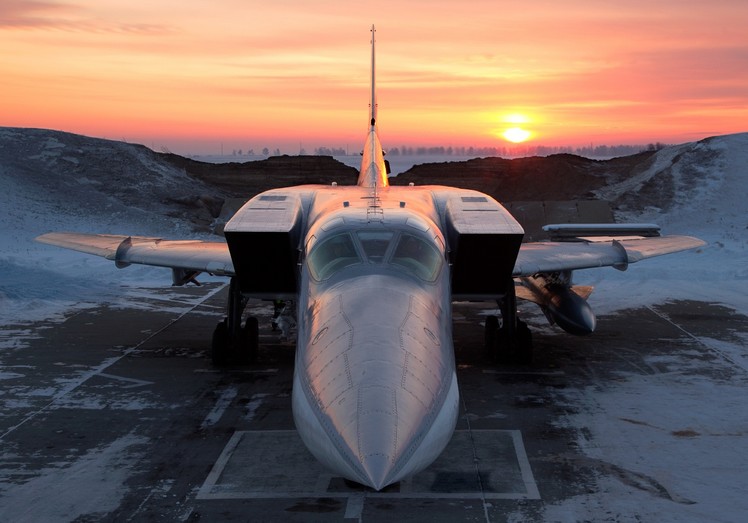
The chassis and the brake parachute
chassis tricycle. The front desk has two wheels with tubeless tires K2-100U "model 5A", automatically braked after take-off in order to prevent the buildup of the nose of the aircraft. Main landing are on 6 Wheel CT-156.010 with tubeless tires "model 1A", and hydraulically forced air cooling equipped with multi-disc brakes MT-500 Electrofans. Track the middle pair of wheels on the main trolley track a bit more of the first and the third pair - a legacy from the first series of the Tu-22M, which had mechanisms razdvizhki wheels, ostensibly for a possible operation of the aircraft from unpaved airfields. All racks have a dual chamber dampers gazomaslyanye. The front strut is retracted into the fuselage compartment backward flight, basic rack - perpendicular, inside. pillar taxiing controlled by pedal and operates in one of three modes: «Rulenie» (large angles), "take-off landing" (small angles) and "samoorentirovanie" (towing aircraft). Landing gear is made from one of the hydraulic systems of aircraft (OK - the first and the emergency - from the second or third). The base chassis 13,51 m, track - 7,3 m, and, as the practice, extremely resistant aircraft during taxiing. To shorten the traveling distance during landing with more weight or limited by the length of the runway is used parachute brake PTC-45 of two cruciform parachutes. Container with parachutes installed below the feed plane between the engines. release and discharge locks operate on compressed air from the pneumatic system of the aircraft and are controlled by buttons on the steering wheel pilots.
Interesting, that the main landing retracted into the fuselage almost simultaneously, but their huge sash alternately tensing, one-and-zero. This is due to some difference in the length of the construction of pipelines for port and starboard.
When servicing flap main landing gear leg can manually open (to the mechanism of each door lock provided halyard forced opening), and then manually close – when lifting the sash lock simply latched (but it has required several people…)
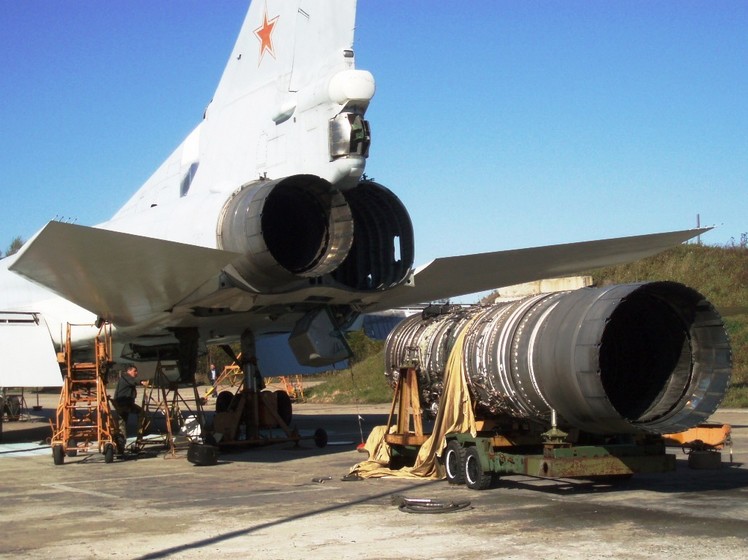
The engine NK-25 near the TU-22
Power point
NK-22 engine ("FM") - the revised version of the multi-mode products "F" (Tu-144), providing a takeoff thrust of about 18,5 tonnes. Use only with the Tu-22M2.
NK-25 engines, or the product "E" - trohvalnye, combi, with an afterburner and a variable nozzle device, with electron-hydraulically controlled fuel supply (The ECM-25 system). Link one motor mode at the maximum besforsazhny (MBFR) is 14 300 kgf, at maximum afterburner - 25 000 kgf, providing thrust-to-weight ratio at takeoff weight 124 ton - 0,403. Specific fuel consumption RT or T-8B - 0,76 kg / hr kg. As used motor oil synthetic oil IPM 10 or 36 / 1KUA, by 29 liters per engine.
Software-adjustable air intakes, the system BMS-10A. Used movable wedge plate to cover the "throat" of the air intake valve and bypass. The system only operates when a Mach number M = 1.25. To supply additional air to the engine at low speeds (on land or take-off mode) each has an air inlet 9 feeding flaps. Between each air inlet and the fuselage has a gap for sucking the boundary layer.
To increase the thrust-to-weight ratio on the plane can be suspended from two or four starting powder 736AT type accelerator. During takeoff with incomplete filling (flights "in a circle") After separation single engine afterburner mode immediately after take off to conserve fuel.
Secondary power system
It provides energy to the system on the ground Jets – DC and AC, compressed air in the air conditioning system and for air starters for starting the main engines. If necessary, compressed air can be supplied to the two installation turbopump, wherein the hydraulic pressure is provided in the first and third hydraulic (GS work on heat pumps is limited in time). Engine TA-6A in a compartment forkil. To access it, serving the right and left have large flaps. When the engine is turning right two open air intake valve, left open the exhaust flap. Engine operation is fully automated. Launching and control of engine parameters and systems (except TNU) – from the workplace navigator-operator.
In addition to working on the land, is possible, if necessary launch TA-6A in air, at altitudes of less than 3000 m. Tu-22M2 before each planting was carried out at the launch of the APU wheel height, so that in case of failure of one engine could quickly provide a complete power supply systems of the airplane. Tu-22M3 is not practiced. Also, this APU due to operation with automatic panel ADF-30TA (Unlike ADF-30A, working with TA-6A aircraft to transport) It has the ability to run fully automatically from the pressing of a button in the workplace captain, with automatic connection APU generator on the network and the launch of TNU – it is done in case of a complete loss of working capacity (death) navigator-operator.
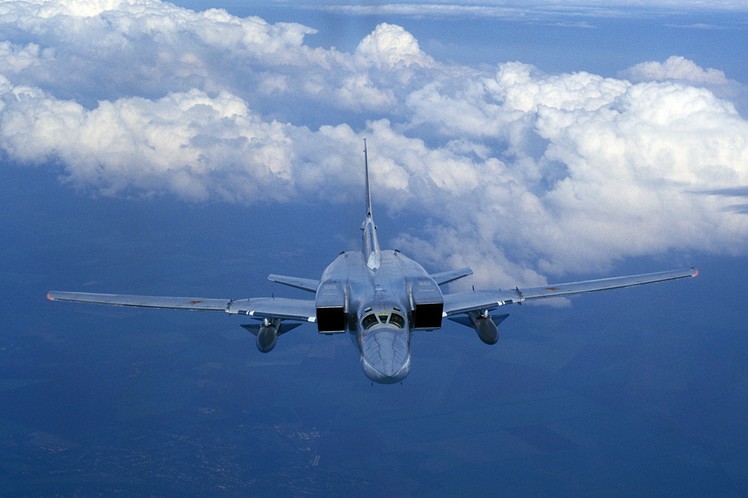
Fuel system
On the plane there 9 tanks groups with a maximum filling capacity up to 67700 liters (actual capacity of the fuel tanks is somewhat different on different planes release series). Bucky number 1,2,3,5,6,7,8 - Soft Rubber, placed in containers, tanks number 4K, 5TO, 9TO, SCHK and PCHK - caisson.
Refilling aircraft fuel is carried out under pressure through a universal charging system (filling four neck located in the lower part of the fuselage trowels. 31-33) performance V = ~ 2000 l / min., for the time t = 35 min. In special cases permitted pistol filling through the upper filling tank neck. The main panel filling is located in the fuel filler flap, left on board the aircraft. Additional panel is located in the cockpit, in the right lёtchyka. Measurement of the amount of fuel and the order of fuel consumption by electronic automation system SUIT4-5 (sensing system, management and alignment), Fuel metering system (flowmeter) RTS-300B-50, and duplicating the fuel metering system SIT2-1. Inside the tanks are installed centrifugal pumping fuel pumps ESP-99M, ETsNG 20-2, ETsNG 10-2, ETsN-75B, ETsN 319 (Total 20 PC.).
The procedure for fuel consumption: Left engine is fed by the front tanks, tank number 2 - Consumption, tank number 1 - centering, sideburns 3-4 - duty, Moreover, the tank number 2 first fuel is pumped out of the left PCHK-plane SCHK, and after full development of fuel tanks of the engine switches to the fuel tanks of 3-4. Right motor fed from feed tanks group consumables 6-9, in which fuel is pumped from PCHK-right plane SCHK, then from 5 tanks, and at the end of production - from tanks 3-4. In normal operation, the fuel tanks 3-4 is divided equally on both engines. In the case of flight with one engine fuel consumption to maintain the alignment and in the range 24,5 – 1,5 % MAR operates automatic centering system SUIT4-5, when the cock is open cross power.
Emergency emptying fuel in flight can drain through the neck and one on planes - in feed, between the nozzles engines, and executed for no more 20 min. Drain fuel afterburner denied, as it causes the stern of the ship fire, Rifle destruction aft installation and partial ammo undermining.
All TC can be divided into subsystems:
– engine fuel supply system and MAT;
– fuel pumping system of PCHK in SCHK;
– fuel pumping system of the tank SCHK № 2 and the tank number 6
– pumping fuel from the tank system № 1 in tanks № 2 and 3-4.;
– fuel circulation system through TZHR.
To prevent the formation of ice crystals in the tanks when flying at high altitudes and blockage of fuel filters in a fuel additive added - liquid "AND" or THF, in the amount of 0,1 %.
The main fuel for the aircraft Tu-22M was made PT fuel. Allowed limited use of fuel TC (followed by replacement of engines).
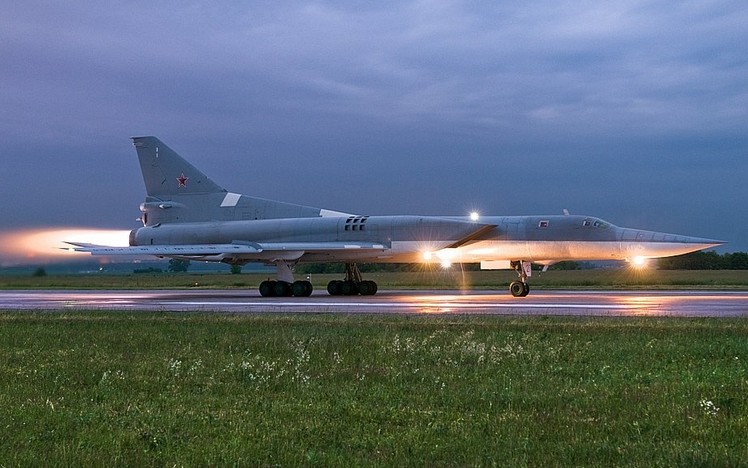
fire protection system
Fire alarm system includes: MSP-2A system (five sets) the first and second stage of firefighting in the compartments, from 90 sensors DPS-1AG; system ATP-1 signaling engine nozzles overheat (installed on the aircraft after № 3686518) from 18 sensors SP-2. Airplanes earlier releases apply additional LS-1 (backup system with linear encoders, disabled due to low reliability and complexity of the operation) and MTP-extinguishing within 11 motor (disabled, and later dismantled), six cylinders UBTS-8-1 with extinguishant "Freon 114b2", piping system and elektrokranov.
The main fire fighting system It includes groups of sensors in the ground plane inflammable: engine nacelle, gruzootseke, otsek VSU, fuel tanks in the planes (PCK and SCK), Technical compartment front chassis legs niche, Front fuselage tank № 1, average number fuselage tanks 2 and number 3. In case of fire the corresponding block BI-2AYU gives a signal to the relay control, which includes:
– flashers "Check Fire" from pilots
– Fire extinguishing unit valves
– the corresponding button, the lamp on panel fire system in the middle panel of pilots
– outputting a signal circuit in the voice data block RI-65
– issuing a single command circuit "Fire" to the emergency recorder MSRP-64
In case of fire in the engine compartment closes the corresponding valve purge DC generators. During a fire, the APU is issued a signal to stop the motor TA-6A and closing flaps inlet APU. After operation block cranes into a fire chamber of three cylinders Freon enters the first fire fighting stage. Commissioning of the three cylinders of the second stage is carried out manually by pressing a button on the remote PPP pilots have. If the first stage is not triggered automatically, it is activated manually by pressing the appropriate button lamp, And second of all, do not turn on, while the first does not work.
If necessary, in the sprinkler system piping can be fed carbon dioxide from the NG system, but a fire in gruzootseke, chassis or engine compartments neutral gas supply is blocked shemotehnicheskogo. The main purpose of NG system - filling the fuel tanks of carbon dioxide when the sortie as fuel generation, in accordance with the program of work of fuel pumps. They can fill all the fuel tanks of the aircraft when the switch is "NG - TOTAL", and only the tail tanks from the 6th to the 9th when the switch is "NG - TANKS 6-9".
When a fire occurs in the compartments of the chassis, gruzootseke in the engine compartment near the afterburning chambers extinguishing media not applicable, and it is only about a fire alarm. To carry out fire control system performance is used to set the right engine compartment of the electronic equipment remote ground control PPO.
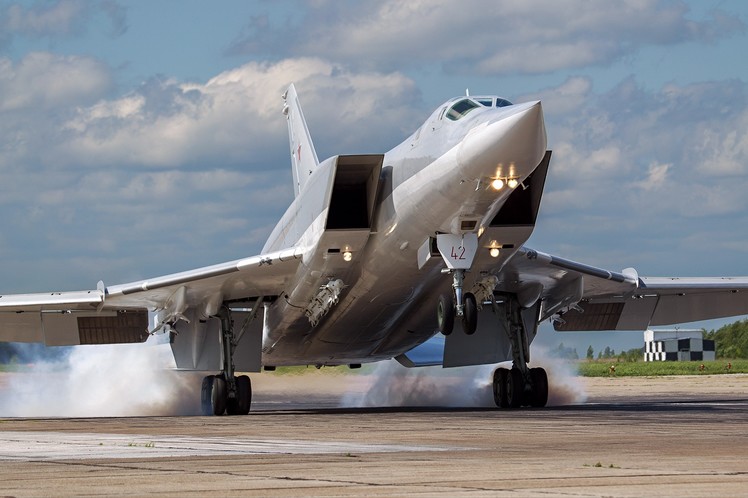
air conditioning system
Tu-22M is a sophisticated, it is very reliable air conditioning system, principally composed of several subsystems. Integrated KSKV conditioning system is designed to maintain normal living conditions for the crew and the required conditions for the equipment and machinery in the cockpit, in technical compartments and gruzootseke, and missile equipment. Jets of air needs to selection is made from the auxiliary power unit on the ground or from the 12th compressor stages of running engines - in flight. Engine bleed air has a high temperature - about +500 °C. You can connect ground-type air conditioner AMK.
In general, the work KSKV. Original Air cooling is the primary air-to-air radiator 4487T in the rear of the vehicle (area 77 špangouta). WWR represents exchanger, which is blown cold air, bleed from the fan motor, and then discharged into the atmosphere. The temperature of the air exiting the radiator is regulated by the electronic control system URTNA-5T. The next loop air cooling are basic WWR type 5645T, right and left, sub-channel located in the engine air intake portion. In flight, blowing radiators produced by the dynamic pressure, and upon the earth for this purpose are the ejectors, working due to the flow of air from the trunk of the cabin pressurization. Ejectors are activated automatically when the aircraft on the ground, that is determined by the compression of the limit switch on the right rack chassis. Ejected hot air is blown down, under the air intakes (a powerful stream of hot air in the winter allows you to bask tehsostavu, but, it is prohibited guiding documents).
The main VVR receives all air, and some of the hot air enters the line bypassing the radiator (hot line). Keeping the temperature of the basic system provides URTNA VVR-4T. After a major highway in the VVR installed damper incorporating SCR pressurized cabin with actuator IPC-15-5. This has two electrical actuators DC motor design - "fast" and "slow". Electrical actuators used for continuously controlling the amount of air supplied to the cabin, while it is working "slow" reversible electric motor, and "fast" motor only works on closing the damper and is required for an urgent cessation of cabin pressurization. The control valve from the working place of the operator with a three position switch neytralyu.nazhimnym. The last step is the complex cooling air from cooling turbines 5394 and two cabin VVR 2806, installed in a technical compartment niche front foot.
Before TX pressure switch installed IKDRDF-0,015-0,001, electrical actuators control valves ejector VVR. Temperature control system for cooling turbines carries URTNA-1T. After TX highway is divided into two: cab heating and ventilation of the cockpit. In the heating conduit through the air valve, prošedšemu TH, hot air is mixed, taken from the trunk to the TX. Quantity of hot air is defined system-1K URTNA. Excess air is discharged from the pressurized cabin pressurization through the automatic pressure regulating ARA-54.
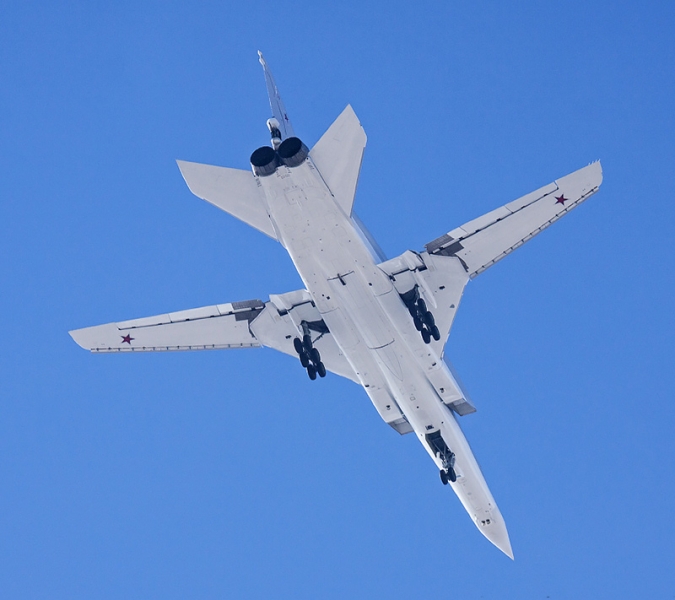
On the flight altitudes of 0 to 2000 m cabin pressurisation no. Beginning with 2000 m and up 7100 m ARA supports the cabin pressure 569 mm Hg. Article, that corresponds to the height 2000 m. At altitudes above 7100 m ARD starts, maintaining a constant pressure difference 0,4 kg / cm3 in the cockpit and overboard. Emergency in the cabin depressurization is performed automatically through the solenoid 438D when the ventilation of the dynamic pressure, depressurization lamp covers or manually - switch.
The air conditioning system tehotseka cooling apparatus serves to block. The air after the main WWR cabin enters the TX and into the pipeline system tehotseka front chassis legs niche. The temperature of the supply air is regulated alternately two controllers with a common actuator. At altitudes up to flight 7000 meters running URT-0T, This system maintains the temperature within 0 degrees, adding, if necessary, to cold air from TX, hot air from the main pipeline to the cabin WWR. At altitudes above 7000 meter-detectors IKDRDA 400-300-0 disable URT-0T and connected URT-10T. This system maintains the temperature of -10 ° C. The same principle works additional cooling system of the nose compartment, which comes into operation automatically provided, that included nasal station "lilac" and outlet temperature of the air has reached the PNA units +40 °C. Blocks aft "Lilac" station outboard air cooled, but if the temperature goes over threshold +40 °C, the air is further cooled in the air-to-air radiator by evaporating the alcohol refrigerant injection.
The air conditioning system VMSK based on the principle of SLE, Air flows from the primary BDP and further divided into cold and hot line. Cold line has two cooling stages, consisting of two BBP VMSK and one TX VMSK, after which the air is divided into two highways: Ventilation and heating. Pipelines ventilation and heating lines are connected to the costume crew seats. VMSK connected to the system through the combined communications connectors type RCA-9A. Every workplace has its own system URTNA-2T to adjust the heating costume, consisting of setpoint 2706A, EC-164B Sensor, Automation unit 2814A and mechanism MRI 1ATV air mixer 501A. Upon cancellation SLE VMSK air emergency power supply is provided from the cabin air conditioning system.
To provide temperature control unit missile guidance equipment SGP and IFP in the nose compartment, and nuclear warheads in the middle compartment of the rocket on the plane the system is installed air-conditioning products, separately for the right-wing, Left wing and fuselage middle missiles. SLE product maintains the temperature in the compartments between +10 to + 40 degrees on the ground and in flight, an air bleed from the airplane KSKV. For this purpose, in an airplane set two more air-to-air radiator with ejectors, Turbo-refrigerating plant, automation units 2714, EC-164 type sensors, speed electrical actuators SLE. Besides, heat removal from each missile nose compartment is made by pumping chilled ethanol-ESP pump 105 in a closed piping system through the aircraft and missile nose compartment heat exchanger. Automatic temperature control circuit consists of an alcoholic 2714S block, IC 164B and an alcohol sensor mixer 981800T, which is set for radiator spirtovozdushnym 2904AT (on a plane three sets).
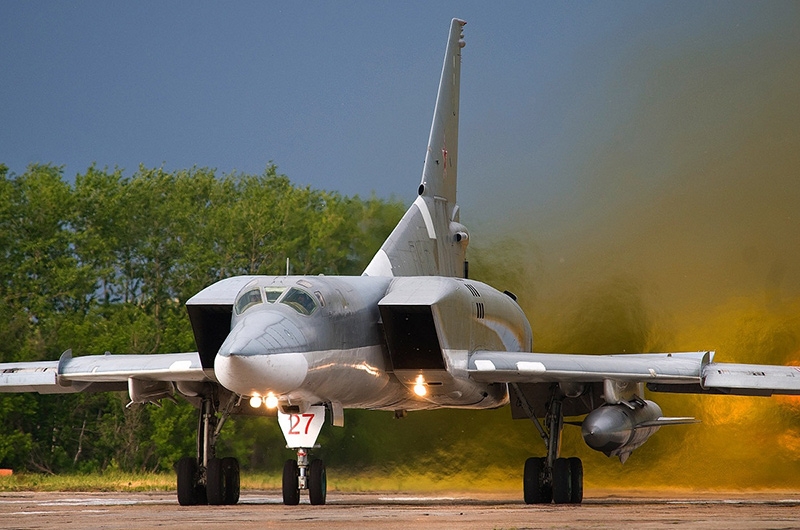
Means of emergency escape and rescue
Each crew member is equipped with ejection seats CT 1M with a three-stage parachute system PS-T, mounted in a chair. Bailout made up, face-to-flow, face protection mask made GS-6A, which is part of the protective suit BMCK-2M, adopted as standard equipment crew, or a protective helmet ZSH-3 (in the latter case, the crew dressed in standard uniforms airfield in season, additionally put on a lifebelt type ASP-74). Bailout is performed in the following sequence: operator, navigator, right pilot, captain. It is provided as an individual, and the forced bailouts.
Forced crew bailout performed commander, which is enough to lift the cap and turn the toggle switch "Forced bailout" on the left side of the cockpit pilots. At each workplace the red banner "Forced bailout" and is included EMRV-27B-1 temporary switch to the right pilot seat, navigator navigator and co-operator, are configured at the time of, adequate 3,6 from, 1,8 from, 0,3 from. Across 0,3 with time relay trigger the solenoid EC-69 pneumatic chair on the navigator-operator, wherein there is an operation on a chair "the ready" system and swaged lamp cap reset switch. When triggered, "the ready" system time included in the armchair automatic ACh-1,2, which through 1 a firing mechanism pulls the pin. Upon exiting the cab seat, on armchair limit switch, which includes the dashboard commander appropriate annunciator panel "The plane left the operator". Temporary Relay chair navigator navigator is activated at t = 1,8 from, and the right pilot seat through t = 3,6 after turning on the switch of forced evacuation. When this happens the system operation, as well as an armchair navigator-operator, and further at the right pilot disconnection occurs on wiring and dropping forward control column. Commander catapulted last, actuating drives bailout on a chair by hand. When leaving his seat detonation limit switch state identification system blocks (ed. 62 "Password"). Forced ejection is the main, individual bailout - reserve.
For individual leaving for each seat has two side handles "the ready-bailout". Enough to trigger the compression system of clicking any of the handles. In the case of leaving the plane without power is only possible with prior individual bailout manual reset input manhole covers (not yet "gone" hatch, It remains blocked chairs the firing mechanism). Bailout is possible at the run or run on the ground, at a speed of not less than 130 kmh (for guaranteed access hatches disrupt airflow), in flight at speeds up to the maximum and practical ceiling.
Chairs are installed in the guide rails. The parachute system is located in the headrest of the chair and comprises a first drogue, second drogue parachute and rescue area 50 m². On the rear side of the backrest frame is set combined firing mechanism KSM-T-45, which is a two-stage solid fuel rocket motor. The first stage - is to shoot accelerating mechanism (after the shot, he remains in the plane), the second stage provides a predetermined flight trajectory chair to the height 150 m. Also on the frame armchairs: chair with a cup of NAZ-7M and the oxygen device KP-27M, detachable backrest with harness and headrest, machinery and automation systems chairs, pneumatic seat. Weight ejection seat of CT 1M 155 kg.
In the case of leaving the machine over the sea each have a single inflatable member of the crew MLAS-1 and portable emergency NAZ-7M with the supply of food and medicines. In the event of a forced landing on water in the container behind the cab has a five-seat inflatable LAS products with 5M stock, medicines and emergency radio. When landing on unequipped airfields or in emergency cases, the crew leaves the cockpit for four rescue halyards, packed in containers on mezhfonarnoy beam.
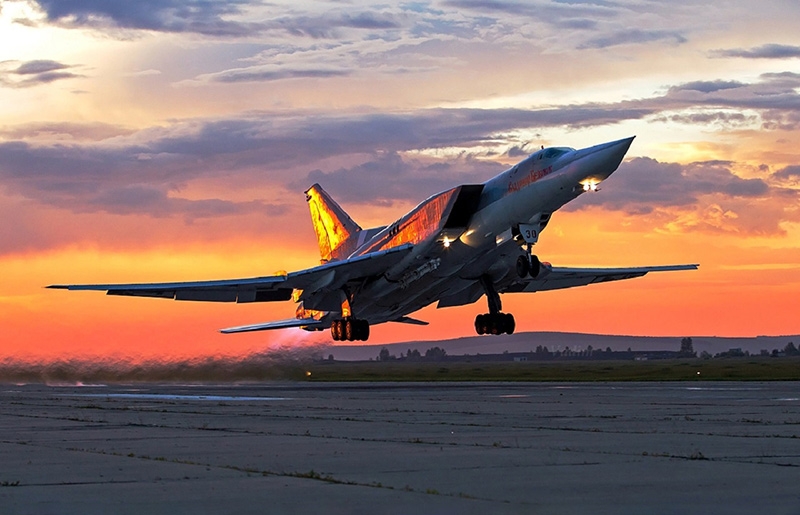
electrical power system
All power supply controls are mounted on the operator's position.
Tu-22M2 left and right organized network - were installed three dynamo GE-18NO current to each motor and one unstable frequency GT60PCH8 (independent of engine revolutions SC-22). For stable networks in the frequency of "Brokeback compartment" were three-electric transducer PT-3000, and three IN-6000, And the workers were only two, and the third was in the "hot" reserve. There were also emergency PO-500 and three PT-125 (or PT-200). Rechargeable Battery - 55-12SAM. The whole was a complex system, cumbersome and unreliable, and did not provide an acceptable quality of electricity supply on-board aircraft systems, and its maintenance complexity caused fair criticism.
Onboard electrical system Tu-22M3 is composed of two redundant DC networks 27 volt, two - three-phase alternating current 208 volt 400 hertz and secondary three-phase current networks 36 volt 400 hertz. The system is divided into a network of right and left sides with multilevel automatic backup system. All generators are electronically controlled and high power quality, without any operating restrictions in flight. Constant current generator produce four contactless GSR 20BK on engines with a total power 80 kW, generate two alternating current drive generator SE-16 or SE-23, with a total capacity of 120 kVA, are two further lowering transformer with 208 on 36 volt. At the APU starter-generator set farm-12TO and three-phase generator 208 V type GT40PCH6. two nickel-cadmium batteries 20NKBN-25 is installed in the engine compartment right, which is enough for the emergency power of the first category of consumers for 12-15 minutes flight. Emergency converters dynamoelectric 36 V - PT-200TS (No three) single-phase and two in the 115 V - IN-500A.
Flight with fully de-energized power plane is not possible (critical voltage level in the DC network - 20 volt). Only offline bailout with manual reset lights caps.
instrumentation system
Tu-22M features a very high saturation cabins - devices, toggle switches and signaling boards are installed on the dashboard, side panels, the upper flaps, ceiling panels (mezhfonarnye beams), rear panels CBA and medium-sized panels (between the chairs). Part of the control and management, which is not used in flight crew, delivered in cab underground (AZS, CBA and additional PNA screen), tehotseki and gruzootseke.
Cockpit instrumentation equipment - conventional switch devices. Basic flight control and navigation instruments - is by the flight PKP-72 pilots on the dashboard and navigation plan PNP-72 from pilots and navigator navigator, set of "On-board 45" trajectory control system. PEP-72, and 72 are PNP-indication "view from the aircraft to the ground". Reserve aviagorizont type AGR-72, angle of attack indicator and overload that comes with AUASP-34KR, turn indicator type EUP-53MK. Indexes speed and altitude - from a kit EVC-3M-1K; additionally installed: Index ASC-2500 rate, Seeing altimeters-90 and HP-20. fuel gauge, movable parts and control mechanization system and engine operation - of the sets corresponding systems. Receivers type pressure LDPE-7, PPD 5.
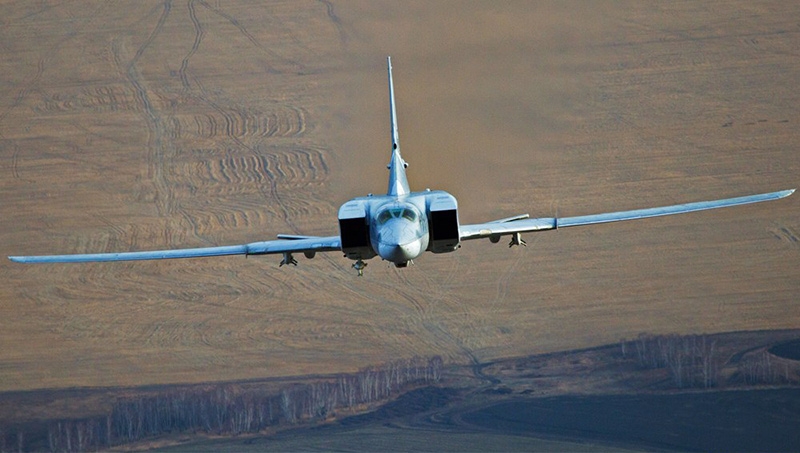
navigation system
navigation system controls are installed in the workplace navigator navigator.
The complex NK-45: malogabaritnaya inertsialynaya system "MES-45», three-channel gyro system and heading "rumba-1A", BTSVM "Orbit-10TS-45» (DCM second generation hybrid ICs), complex switching units CCL-45, units and the control and switching panels, automatic mapping tablet PA-3, exchange rate system "Comb", and the conjugate system: radio navigation RSBN-PCI, The calculator-144, DISS-7 Meter, Station A-711, A-713, A-312, planting apparatus "axis 1", altimeter RV-5 and RV-18, radio compasses ARK-U2 and ARC-15.
Navigation system SC-45 in conjunction with an automatic trip-145 AFCS control system enables the programmed automatic flight according to one of the two embedded ("Stitched" in memory of the onboard computer on earth) routes, since the height 400 m. Before each flight route two storage cassettes are inserted into the block memory onboard computer with sewn route (programming group), and PA-3 plate inserted gluing of topographic maps and diagrams airfields. In flight the plate visually displays the current location of the aircraft relative to the terrain.
Automatic on-board control system (ABSU)
The thin, flexible wing with a negative twist endings, advanced mechanization and the presence on board of a complex automatic control system with multi-level "foolproof" aircraft in the flight environment was nicknamed "brick". For its management does not require a permanent job and a steering wheel column (as in all previous, and the many subsequent aircraft), it is almost indifferent to any "bumpiness", the loss of speed, it does not enter into an uncontrollable flat spin (the majority of heavy aircraft), just flat pancakes, maintaining stability and controllability. Some bullies to hundred-ton machine managed to perform a "barrel".
ABSU - a complex system, It is consisting of ACS-145m, DUI-2M, "On-board 45" and is working with a number of conjugated radio and navigation systems. It is in electrical communication with almost all aircraft equipment.
Purely manual control on this type of aircraft is not provided, and turn off the power AFCS during flight is strictly prohibited.
AFCS simplifies piloting, adjusting the flow rate and column balancing position, depending on the flight mode, and automatically fending off all unauthorized aircraft evolution, caused by instability of the air mass. When you perform coordinated turns automatically compensated for the loss of height, with the release of the flap is automatically compensated dive time, with changes in the longitudinal overload gradually limited flow column and the gear ratios on the handlebars, It is automatically compensated by the reverse reaction of the rudder, effectively extinguished buildup. It is also possible to control the aircraft not only moving column, a steering wheel and pedals, but also on the drill handle on the control panel CP-35 (type "joystick" on the average, the remote pilots), which synchronously moves the entire flight URC, tracking the angular position of the plane in space (that is necessary for bumpless transfer control "with the wheel" to "automatic" and vice versa when the aircraft evolutions, and that is impossible in principle to the same type of (although later) AFCS passenger airliner Tu-154), due to lack of follow-up system (Flight mode for changing the plane every time you need to put in the "horizon"). The automatic modes is possible with automatic flight stabilization of the angular positions, velocity, height, exchange rate, azimuth; software route management, automatic access to the target or to a point missile launch; automatic return to the airfield, automatic or set-director and a decrease on the glide path to a height 40 m; automatic flight rapprochement to visual contact with any aircraft, equipped with radio navigation transponders; the loss of orientation in space pilot automatic elimination of the aircraft at a steady level flight with subsequent stabilization barometric altitude - from any angular and spatial position, in excess of operating overload up to 5g, if stored machine control.
Tu-22M2 and the earlier series of Tu-22M3 units installed automatic low-altitude flight (NVP), Allows you to perform this kind of flights over sea or flat terrain. Overall, CWT system failed and has been disabled, and on the subsequent series of Tu-22M3 was not set (AFCS-145m Series 3-3). AT 1975 g. a group of Tu-22M-2 made a long low-altitude flight, at the height of which areas was reduced to 40-60m.
Shemotehnicheskogo ACS-145 and JUI-2M - analog decisive (high-speed calculation of the current time) system (integral-differential logic). They are collected on a series of integrated operational amplifiers 140 and 153 (dc amplifiers DCA-9 and other microassemblies) and discrete passive diode logic elements. First used double-sided printed wiring microassemblies.
The accuracy of the AFCS is characterized in particular such parameters: adjusting the error of steering deflection plane surfaces, managed AFCS, is no more 5 arcminutes; total operational error - no more 30 minutes for all, the most difficult Flight mode.
This AFCS weight advantages when maintenance requires a large volume of. In view of the analog system construction, replacement of any unit, the sensor unit or in the control system or related systems require many hours and a comprehensive inspection system migration, and in some cases, and control of the aircraft flyby. Periodic work AFCS very complex and time consuming, require a harmonized calculation of a minimum of three competent and trained professionals ITS.
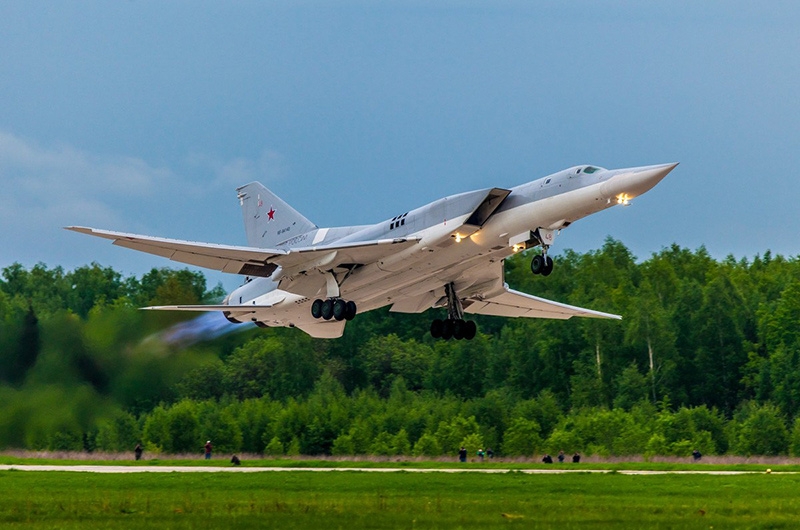
objective control means
The onboard equipment control objective - voice recorder MS-61 negotiations, barometric recorder K3-63, recorder apparatus parameters PNA - recorder SARPP-12VM, Magnetic recorder filter parameters MSRP-64M-2(5), fotopristavka to control the visual information of the PNA - FARM-3U. Can be installed on the gun camera tube screens rifle scopes. A number modified in the 21st century aircraft instead of tape got SSDs flight information.
avionics
In this type of aircraft found: communication equipment (RSO), radiotehnicheskoe (MM), radio navigation (RNO), sighting and navigation (INT), electronic warfare (EW).
radar INT ("The planet-carrier") It is a selective forward-looking station, with the signal power in the pulse to 130 kW, redundant (It has a second transmitter, Reserve information processing equipment and communication). Radar is also used for navigation - correction path and coordinates in SC-45. Shemotehnicheskogo station PNA Tu-22M2 is no different from the station on the Tu-22M3.
Radio communication equipment includes:
– two command VHF P-832M,
– srednekorotkovolnovuyu station LD P-847T,
– Reserve a shortwave receiver P-876T "Comet";
– code equipment and automatic communication of information P-099 «Seagull», which works together with the station TLG ZAS "12-65" and STA ZAS "19-18".
– Emergency radio station R-855 "Sea anemone",
– Jets intercom type SDA-7,
– Bitching Betty - RI-65B.
Aircraft radio navigation equipment, not included in the range of NC-45:
– radio range navigation and landing RSBN-PCI,
– planting apparatus "axis 1" in conjunction with the trajectory control system "Tail-45" from the kit AFCS-director of a 145m implements and automatic modes when landing in SP-50 Systems, "Catete" or ILS on international standards 2 ICAO category,
– mezhsamolotnoy finder navigation ARC-U2,
– automatic radio navigation and landing ARC-15M,
– navigation equipment long A-711 "Silicon" (It works with radar PNA).
– The digitizer coordinate A-713 "Coral", It works in conjunction with RSDN "Silicon" .Radiovysotomer altimeters RV-5, an airplane is equipped with two sets of.
– Altimeter RV-18 high altitude.
– A radio navigation-311 "Pechora",
– azimuthally rangefinder receiver A-312, It works in conjunction with RSBN.
– True Doppler velocity and drift parameters Diss-7.
EW means
– On-board defense complex - the product L-229 "Ural" ("Birch", "Poppy" and the overall management of. Machine-2, Machine-3 cartridges and holders before and LTC are weapons system).
– IFF system - the product 62 "Password"
Lighting equipment
Lighting equipment consists of four drawers planting-rulozhnyh headlights PRF-4M, two in the bow below the fuselage, just behind the radome radar, and two - in podkanalynoy parts vozduhozabornikov. Headlamps are cleaned automatically, immediately after takeoff, at speed 360 kmh. Navigation lights consist of halogen lamps on consoles planes - red and green, and of white light on the top rear of the keel. ANO can be operated in a three-stage brightness mode, blinking or continuous combustion (block BUANO-76, of IL-76). Strobe lights include two lamps "SI" white light with pulsed mercury vapor lamps with a capacity of 600 W, installed at the bottom of the bay front undercarriage leg and the top of the input channels air intakes. Also on the plane flight formation lights are used, consisting of eight OPS-69 orange lamps, Located on top of the fuselage and PCHK, and in terms of forming a "T" when viewed from the top rear of the aircraft, and two white lights, located midway endings stabilizer. Cabin lighting Flight - red and ground - white, shadowless lamps. The total number of cabin lighting lamps - about 550 PC.
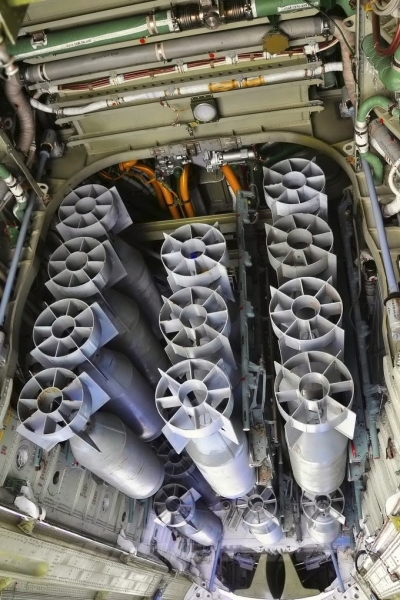
Bombs on the inside of the suspension of the Tu-22
Armament of the Tu-22MZ
Tu-22MZ is designed for combat operations in the operational areas of the land and naval theaters of war to destroy the moving and stationary, radar-contrast and area, visible and invisible goals (objects) missiles and bombs day and night, and adverse weather conditions. The aircraft performs the following tasks:
– strikes three missiles of the type X-22 in the range of heights of filter media by 1000 m to a practical ceiling on the radar visible and invisible targets, range 500 km speed 1 km / sec;
– defeat 6 (in the body) +4 (wings) missiles of the type X-15 ground targets with known (programmed) coordinates, range 300 km, speed 1,7 km / sec;
– perform precision bombing svobodnopadayuschie unguided munitions in the range of H 200 m to the practical ceiling (maximum bomb load 24 000 kg);
– performing optical, thermal, radar, radiation and other types of intelligence (Tu-22MR aircraft).
The aircraft can carry three (in overdrive) anti-ship cruise missiles X-22 (medium-range missiles into the fuselage poluutoplena), svobodnopadayuschie bombs or naval mines of various calibers (to 69 PC. FAB-250), to total weight 24 000 kg. Normal combat load are the two X-22 rocket or bomb weight up gruzootseke 12 000 kg. Perhaps the location of bombs, and on the external sling (2 beam holder MBD3-U-9M) under air intake channels. Typical loading mine variant envisages the suspension of eight minutes, type RM-1, UDM, UDM-5, APM, AMD-2, «Lyra», "Sickle", or 12 min AMD-500M, or 18 min IGDM-500, UDM-500. Any aircraft can drill in a relatively short period of time forces personnel converted into rocket, mine bomb or mixed variant arms through missile disassembly beam holders and install and cluster bomb beam holders in various combinations. The use of missile weapons or bomb automated and carried out by the navigation and bombing system (NBS), which included the PNA radar, Television-optical bombsight 015T, associated with flight and navigation system (PNA).
Planes after the 90-series are equipped with Suro (missile weapon control system) IN-001, , with four suspension aeroballistic Kh-15P on the PU-1 at the wing root (SCHK) and six Kh-15P in the tympanic (MKU-6-1) launcher in gruzootseke. For tactical launches (crews workout) It applies a suspended rocket simulator I-98.
For the defense to use remotely controlled aft gun mount the UCF-9A-502M with a 23-mm cannon GS-23M, with a shortened barrel unit and the increased rate of fire (to 4000 Venue / min.). ammunition is 750 PEAKS shells and PRL. Aiming is carried out by a television (TP-1km) or radar (LFS-4 "Krypton") feed, with a range of target lock around 4 km and the possibility of doing avtoognya (system 9A-502 and PRS "Krypton" involve identification "friend or foe" system). In connection with the huge rate of gun introduced automatic cutoff circuit after turn 25 shots.
On this same system was installed Tu-22M2, but with a tower under two guns GS-23 (also without localizers) and two ammunition boxes each on 600 rounds. under the tower, between the nozzles installed engines "trousers" - the socket to reset shoot cores. How to install the tower Tu-22M2, and the M3, on gun barrels block mounted massive stainless steel housing.
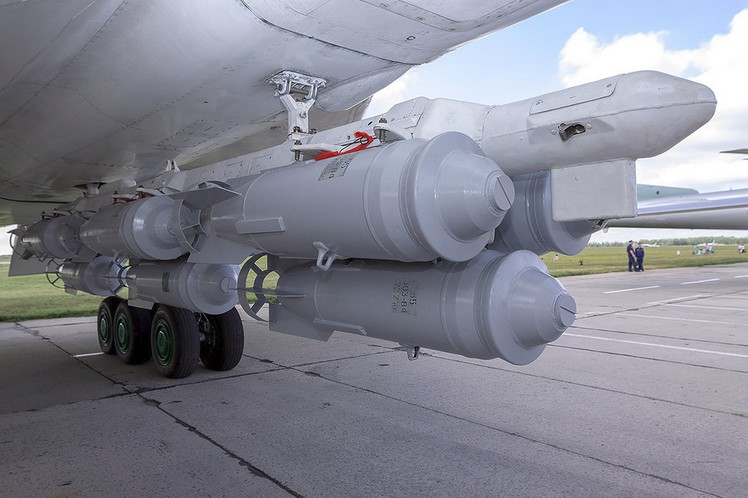
Bomb on the external load of the Tu-22
coloring aircraft
All drill Tu-22M2 and M3 painted in white bottom, from the sides and from above - in a light gray color. The internal design of the aircraft was not painted and had a light green primer color of duralumin. Boxes electrical and faceplates blocks AO REO and had a light gray color (enamel PF-223), older avionics, including some of the controls in the cockpit navigators, painted in black. Interior jobs crew was light gray in color, All dashboards, plates and panels - emerald green.
Airplanes Tu-22M2 gruzootseke walls are painted in a light green color, ceiling in white. Tu-22M3 all gruzootseke, with the exception of the valves and the DB-45F, painted white. Landing gear bays and gray, but on some machines landing gear partially painted in white or "metallic". All wheel drums were painted in dark green, but caps on the main landing wheels painted in dark green, and "silverfish" (aircraft met with hub caps of different colors on a single rack).
Technical inscriptions made darker gray. After planned repairs and repainting the factories specifications can be labeled what color you want, and even without a stencil - "by hand" brush, crookedly and obliquely.
Rooms on all planes were painted on top of the keel and on the wings of the front chassis, And the BBC the number was drawn only on the front flap, and the sailors and painted on the front, and two lateral. Rooms are mostly red, after the collapse of the Soviet Union Ukrainian Tu-22M received a blue room.
In the 90s in some garrisons planes began to paint - from harmless white rings on the wheels to huge shark head on the air intakes. Some planes received personal inscriptions and (or) Guards signs.
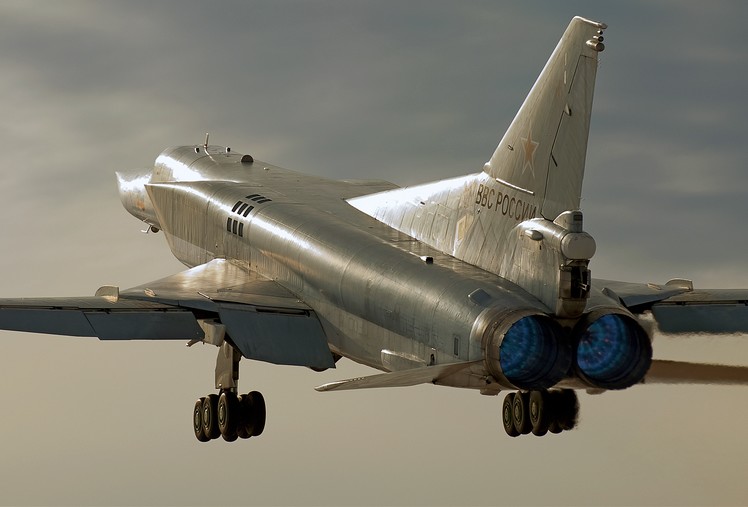
modifications
Tu-22M
28 November 1967 the Council of Ministers of the USSR issued a decree number 1098-378, according to which before the Tupolev task was to design a modification of the Tu-22K - Tu-22KM with variable sweep wing and two DTRDF NK-144 (NK-144-2). Thus was the beginning of the official stage of development Tu-22M Series. In the autumn 1967 year as a result of mock-up committee and the materials of preliminary design, it was decided to begin construction of a series of Tu-22M («45‑00») at the Kazan aircraft plant them. Gorbunova (KAZ im. Gorbunova, until the mid-1960s the plant number 22 MAP). Chief designer of the aircraft was assigned D. FROM. Markov. The result of the mock-up committee in the fall 1967 it was decided to build a series of experimental aircraft, "45-00" on the program of the first stage - the equipment from the Tu-22K engines and "FM".
The first Tu-22M was built by the middle of 1969 of the year, and 30 August, he made his first flight (commander - test pilot in. P. Borisov). In parallel with the tests in Kazan went two more production machines. By the end of 1971 , it was built 9 Tu-22M units, five of which were used for training bomber crews in the Center of combat training and the use of long-range aviation in Ryazan. In the west of the planes of this series for a long time known under the official name of the Tu-26.
During flight tests revealed, that the basic data, flight new aircraft were even worse, than the Tu-22K, and the need to spend a large amount of work on its modernization. The Air Force required to improve the flight performance of the aircraft and its avionics. December 1969 during the second stage of fine-tuning the Tu-22M decision to modernize the Tu-22M in the Tu-22M1.
Tu-22M1
FROM 1970 at Tupolev conducted design Tu-22M1 («45‑01») taking into account the experience of development and testing of the Tu-22M0. In the course of modernization have significantly (on 3 tons) reduce the weight of the airframe and improved aerodynamics. Significant changes have undergone the air intake structure, Mechanization and geometry wing, defensive weapons system (installed remote-controlled gun mount 9A-502 with two guns GSH-23L and ammunition in 1200 shells) and color scheme: the airplane was painted in gray, the lower part of the fuselage and planes - in white "anti-nuclear" (English. Anti-flash white) Colour. For the first time on a plane of this class was equipped with multifunctional automatic onboard control system AFCS-145 with reversible hydraulic actuators and a channel-by-wire roll. The complex of works on offensive weapons, in particular modification performed missiles X-22 X-22M (D2M product), preferably at guidance system.
In summer 1971 years at the Kazan Aviation Plant has completed construction of the first Tu-22M1 with engines NK-144-22. 28 July 1971 , began its test flights. Even before the end of the test it was decided to begin serial release of the aircraft. To end 1972 KAZ year built five aircraft Tu-22M1. Some of them are used to test the final design of the aircraft and its systems, part was transferred to the 33th Combat Training Center for Naval Aviation.
The parade of the Soviet Air Force Tu-22M1 is not done. In a large series, it was decided to build the Tu-22M2 - further development of the Tu-22M1 with engines NK-22 (thrust 20 000 kg each), which it managed to get rid of many of the shortcomings of previous versions of the Tu-22M.
Tu-22M2
Tu-22M2, as well as the further development of OKB on "45", superficially left of TU-22 only the front part and the rack chassis gruzootseke with semi-flush missile X-22H. All the rest, anyway, been transformed.
Tu-22M2 («45-02») planned building with improved NK-23 (22000 kgf, 0,85 kg / hr kg) with the possibility of replacing the more powerful and efficient engines NK-25, but all serial machines have NK-144-22 series 2, a thrust in afterburner about 20000 kgf (NK-144 had afterburner thrust 17500 kgf). Reduce the weight of aircraft expected approximately 1400-1500 kg. Avionics TU-22M2 was structured in a number of interrelated on-board systems:
– digital-to-analog navigation system NC-45 FDC "Orbit-10TS-45";
– AFCS automatic board 145m-by-wire control system with a channel on a roll;
– dvuhkanalynaya pan-pritselynaya radiolokatsionnaya station HOP;
– opto-TV with an 8-fold increase (zoom) bombing sight OPB-15T;
– TP-1km television gunsight
– EW system - "Lilac" station.
Actively worked to improve the aerodynamic qualities of the airplane (especially in flights at low altitudes in order to overcome the enemy's air defense). crew ejection system at all Tu-22M was made up, Unlike TU-22. Generally, aircraft performance characteristics of the aircraft remained at the level of the Tu-22M1.
The first was built at the Kazan Aviation Plant Tu-22M2 has made flight 7 May 1973 of the year (testing and refinement continued until 1975 of the year). At night 14 May 1976 year on a production Tu-22M2 commanded in. P. Borisov made a test flight at maximum range with a single aerial refueling. Range of flight of the aircraft was about 7000 km. The flight was recorded by American intelligence satellites, and the next day the flight map was provided by the US delegation at the Geneva talks on the Strategic Arms Reduction SALT-2. Despite all the efforts of the delegation of the Soviet Union under the leadership of Minister of Foreign Affairs A. Gromyko, Americans insisted on the inclusion of the Tu-22M2 in the list of strategic forces of the USSR, although, in fact, the aircraft was unable to work for the US. After a long and heavy negotiations an agreement was reached on the dismantling of all machinery refueling boom and the limitation of serial production of Tu-22M at 30 vehicles per year.
Americans were active in the exploration and were well aware of the possible effectiveness of combat use of the Tu-22M2. Main aircraft weapons - antiship cruise missile hypersonic X-22H with lightweight high-explosive shaped-charge warhead capable of causing aboard holed area 22 m² and a depth of 12 m. Areal missile X-22PSI megaton warhead equips, with the launch range almost 500 km. The plane with one stroke Freefall bombs plowed area, equivalent area 35 standard football fields. The possibility of sighting equipment allow to get a single bomb in a barn with a ten-height. For the leadership of the USSR aircraft show was arranged, for which the landfill built marching column layouts tank regiment. One Tu-22M covered areal bombings blow the whole column, and at the same time issued the windows at the observation post, where the delegation was. L. AND. Brezhnev, I am very impressed by what he saw, He awarded the Order of the commander of the crew of the Red Banner.
In August 1976 , the Tu-22M2 was adopted for naval aviation and long-range aviation (rare case, when the new car first enters the naval aviation). Serial production of the Tu-22M2 continued until 1983 of the year. During this time it was built 211 Tu-22M2.
One machine of the first series of Tu-22M2 converted into Tu-22MP - jammer-pointer and a carrier X-22MP missiles with semi-active guidance systems on enemy radar radiation - GWP-K. In the bow of the aircraft additionally installed radar "Rate-N", in the cargo hold – Technical compartment interference apparatus. These works have been caused by the need of additional exploration and jamming AUG to strike group Tu-22M. However, in the shelves, all of 1980 and the beginning of the 1990s, used for these purposes specialized Tu-16 and Tu-22. Tu-22MP passed military tests in the Far East, which revealed many shortcomings, including failed to achieve coherence in the work of various equipment. In further modification of the Tu-22MR has been created for this purpose, which have not been brought to practical application, due to the collapse of the Soviet Union.
the further development of the project work, to improve the aerodynamic performance of the aircraft and the emergence of new, more advanced engines has led further to creating the most advanced production series Tu-22M - Tu-22M3 («45-03»). Despite all the shortcomings identified, Tu-22M2 actively exploited. Completely normal thought to raise the alarm 9 of 10 aircraft in the squadron. However, in the garrisons were constantly industry representatives (mobile teams) and implemented numerous improvements. By the mid-1990s is far from the old Tu-22M2 is no longer flying and began to actively disposed of. On the part of machines cracks were discovered in the wing structure, but the reasons for such surgical destruction of a large fleet of aircraft have been, rather, political.
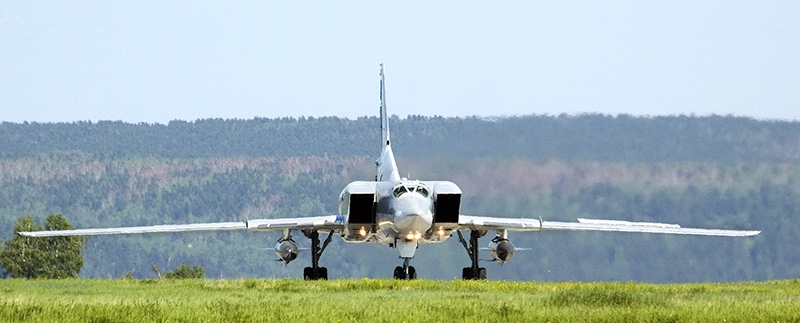
Tu-22M3
In January 1974 VPK year at the Council of Ministers adopted a decision on the further modification of the Tu-22M2 by NK-25 engines. It was supposed to replace the engines, to introduce a number of significant improvements to the design and the aerodynamics of the aircraft and to upgrade most of the on-board equipment and systems, in particular, It involves the installation of a new radar sighting system. 26 June 1974 year came the USSR Council of Ministers № 534-187, determines the development of the Tu-22M with engines NK-25, with improved aerodynamics of the airframe, with reduced empty weight of the aircraft, and with improved performance tactical and.
The new aircraft modification, dubbed the Tu-22M3 («45-03»), more powerful and economical engines NK-25 have been installed with an electronic ECM-25 control system. the design has been modified air intakes, which are now positioned at an angle to the fuselage (similar to the MiG-25), several unloaded wing, since inlets become part of the supporting structure. Reducing the dynamic resistance at low speeds improved flight characteristics of the aircraft. Completely changed the aircraft electrical system. Installed new generators, brushless, electronically controlled and constant speed drive, dismantled six-electric converters. Rather than lead-acid batteries 12SAM-55 installed two alkaline nickel-cadmium batteries 20NKBN-25U3. These activities significantly improved the quality of on-board power supply and the overall reliability of electronic aircraft systems.
An attempt was made airborne defense organization. Scattered equipment and systems connected to the BKO L-229 "Ural", teplopelengator with L-083 "Mak", ACT LO06 "Birch", jammers SPS-151-153 "Lilac" and SPS-5M "Beans", holders of the AMS-50 traps (or CDS-155), automatic reset passive interference APP-22MS ("Machine-3") and a pair of reflectors automatic reset ASO-2B-126 ("Auto 2"). In practice, the only aircraft equipped with the latest series of full BKO. Most of the first series of machines are on board a truncated version, and some do not have any means of defense, except fodder gun GS-23 with shells PEAKS and PRL. However, on the application is far from being a modern BKO imposed a number of restrictions.
payload incurring system also changed, allowing simultaneous bearing and missiles and bombs. forward fuselage design also has been redesigned, modified refueling boom (on the drill rod machines it is not installed). Carried out a set of measures for improving the glider, improve sealing joints and manholes and reduce aircraft empty weight (in structures began to be widely used titanium). All weight reduction measures to, even with the heavier new engines, We were to provide overall reduction in aircraft weight 2300-2700 kg. With the modernization of onboard equipment had many problems, mostly related to the unavailability of new systems to be installed on aircraft. Developers and vendors could not withstand periods, so we had to postpone the replacement of avionics on an uncertain future.
The first prototype of the Tu-22M3 aircraft made its first flight 20 June 1977 of the year. After performing the flight-test program debugging Tu-22M3 with 1978 year run in serial production. C 1984 year cut production of Tu-22M2 and mass production can only modification of the Tu-22M3. Somewhat later, the Tu-22M2 were built with a wing of the Tu-22M3, as part of the Tu-22M3 is built with the equipment and the elements of the airframe of the Tu-22M2 (transient machine). FROM 1981 by 1984 during the aircraft passed an additional set of tests in a variant with enhanced combat capabilities, in particular, application was developed using the X-15 rocket. In final form, the Tu-22M3 was adopted in March 1989 of the year.
The last Tu-22M3 built in 1993 year (due to non-payment by the customer in a plane is set as a monument near Kazan aircraft plant). All at the Kazan Aviation Production Association was built 268 Tu-22M3. AT 1992 year on the basis of serial aircraft created flying laboratory Tu-22MLL, for field research flight. At the disposal of the Russian Air Force was to 70 Tu-22M3, 83 Aviation aircraft were available for Russian Navy. All conditional serviceable (prepared for a single distillation,) airplanes in the Navy 2011 He was transferred to the Air Force. There were other projects for the development of the Tu-22M based on the use of upgraded engines, new systems of equipment and weapons - Tu-22M4 (one aircraft was built in 1990 year) and Tu-22M5. project "45M" was developed for the Navy, the original arrangement and two X KR-45. The further impact of the interceptor - Tu-22DP. For export abroad designed Tu-22ME. As part of the conversion project is considered an administrative ATP Tu-344.
On the basis of Tu-22M3 worked aerospace system design for output to low orbit satellites weighing up 300 kg - be it research or satellites, for example, satellite mobile communication systems. This significantly reduces the cost of running (by approximately 20-30 %). How to create a carrier aircraft based on the Tu-22M3 within VKS, in particular, flying laboratory with scramjet "Raduga-D2".
In January 2017 of the year 6 Tu-22M3 long-range aviation in Russia dealt with air strikes against targets LIH in the province of Deir ez-Zor Syria. One hour flight of the Tu-22M3 is required 51 man-hour of technical maintenance.
Tu-22M3M
To 2020 planned upgrade at the Kazan aviation plant to 30 Tu-22M3. The task is to extend the life of the airframe to forty calendar years, as well as perform works on offensive weapons plane, which no longer corresponds to modern requirements. In particular, It plans to install the equipment under the new missile Kh-32 (ed. 9-A-2362), which more than 25 years from the beginning of development have adopted (at the end 2016 of the year). X-32 – is deeply modernized missile Kh-22 with greater range and altitude of flight, and the most important thing – with a brand new noise-GOS, able to operate in conditions of use EW means adversary.
The project Tu-22M3M (product 45.03M) based on the project Tu-22M4, work that took place in the late 80-ies of the last century and have been discontinued. The main purpose is to use aircraft with high-precision cruise missile “air-to-surface” X-32, with minimal changes on the airplane systems: improved characteristics of the onboard radar “INT” in range, resolution and noise immunity, installed a new missile weapon control system (beamed holders remained unchanged), changes in the onboard power supply system. By plane preserved the possibility of using the whole range of ammunition Tu-22M3.
As part of the development work on the topic “Potential” OKB “Tupolev” finalized the Tu-22M3, board with № 9804 (time. № 4898649). On the plane was set to apply the desired equipment Kh-32, as well as additional control and recording equipment. According to unconfirmed reports the aircraft according to the documents held under the code “product 45.03-1” and during the test 2013 He was based in Ramenskoye.
also in 2012 he converted one plane (board room 37) under the new targeting and computer system SVP-24-22 "Hephaestus", which passes the test set and airbase dovodok Dyagilevo in g. Ryazan. SVP-24-22 complex comprises: SRNS-24 radio navigation system, SV-24 computer, IO device IOCTL-IP-22, flight information generation unit – GIM, collimator aviation KAI-24 LED, Solid State Drive Information – TBN K-2. Detailed information about the conducted works on modernization is closed. At the end 2016 year aviation-missile system “object 45.03M – product, 9-A-2 362 with TC-56” adopted for.
Tu-22M3R
December 1985 , began flight tests of long-range reconnaissance aircraft-designator and jammer Tu-22M3R (products 4509), designed based on the Tu-22M3. AT 1989 by aircraft under the designation Tu-22MR transferred into mass production. The first experimental machine is lost in a plane crash. Subsequently built or converted in reconnaissance version of the Tu-22M3 12 Flight. The plane was originally supposed to scout, jamming and targeting the shock group of Tu-22M, but due to the collapse of the USSR was not executed program. To ensure the combat mission of the Tu-22M in the 1980s and 1990s was a squadron of Tu-16 in the state of regiments to reconnaissance variants and jammers.
Tu-22M4
The development of "products 4510" began in 1983 year. Modernization with installation of new engines NK-32 (of Tu-160) and with the change in engine air intakes. Avionics modernization by installing new PNA, Radar "Browse" (of Tu-160), complex EW. Expansion of the range of means of destruction: 3 H-OR 32, or 10 X SD-57 (with accommodation 6 internal and 4 external hardpoints) or UPAB-1500 with a television homing system. AT 1990 , the prototype was built at the Kazan aircraft plant. Work in this direction was discontinued in November 1991 of the year. The prototype is in the museum exhibition Diaghilev AB.
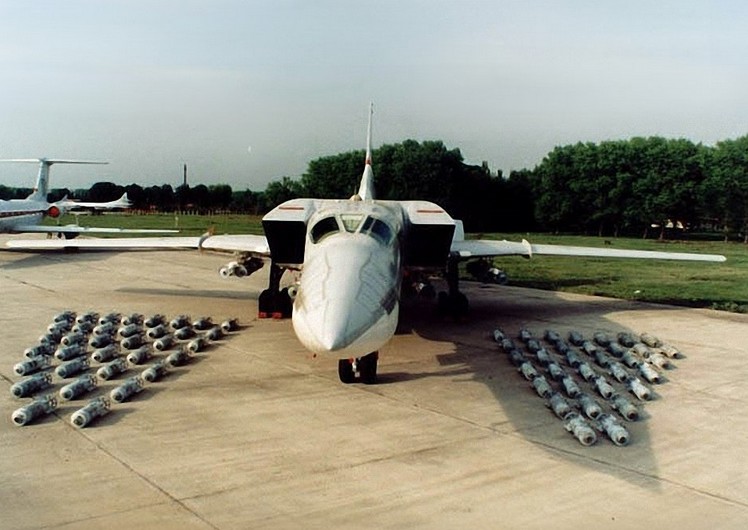
modernization
To 2020 planned upgrade at the Kazan aviation plant to 30 Tu-22M3, setting them on the equipment on new element base and adapted to the expanded range of weapons, including modern high-precision, providing a defeat not only for strategic and large stationary moving targets, but also of small tactical objectives. It provides for the improvement of avionics (in particular, installation of a new radar), reduce radar visibility. Also carry out a complex of works on the extension of the resource to 40 years. These aircraft carried the designation Tu-22M3M (Backfire-E).
After proper modernization can carry precision-bomb type KAB-1500 and BAC-500 with laser homing bombs and KAB-500S with GLONASS guidance system. After upgrading can also be used more modern missiles of the type X-31, X-35, X-38 and X-41 and X-65 cruise missiles, X-101 and X-555.
Export
The possibility of selling the export version of the Tu-22M3 foreign countries (as potential buyers were called such countries, how Iran and China), However, for political reasons so far not a single contract has not been signed.
reported, Iran has bought seven aircraft for the Navy bombing missions and in anticipation of a possible military conflict. But the deal has not been perfected, Post has been completely refuted by Rosoboronexport, and subsequently the Russian Federation Government.
At the beginning 2013 year on the Internet rumor about the sale of twenty-five bombers Tu-22M3 in China, and plant equipment for further production.
2001 g. – at the air show in Bangalore announced its intention to put the leasing 4 Tu-22M3. No other information.
2004 g. December – Russian Defense Minister Sergei Ivanov said that, that an agreement on a mutually acceptable solutions for the supply to India Tu-22M.
Iran – in July 1992 g. We negotiated the sale of the 12 Tu-22M export version. As of December 1992 g. the supply of the contract is (not confirmed).
It should be armed
Russia: 62 Tu-22M3 and more 1 Tu-22MR, as of 2017 year
Withdrawn from service
the USSR - then moved into the Russian Air Force, Ukraine and Belarus.
Byelorussia - deduced to Russia.
Ukraine - Tu-22M consisted BBC Ukrainian service in 1992-2003. FROM 2002 by 2006 year at airbases in Nikolaev, Poltava, Priluki and the White Church was destroyed 60 Tu-22M (17 Tu-22M2 and 43 Tu-22M3), and is also on the bases of storage and repair plant. Also, Lakeside at the air base had been destroyed 423 aircraft cruise missiles X-22. It has been left to the museum exhibition 4 Tu-22M, of which one Tu-22M3 is located in the Poltava Museum distant and strategic aviation, and one Tu-22M0, Tu-22M2 and Tu-22M3 - State Aviation Museum of Ukraine.
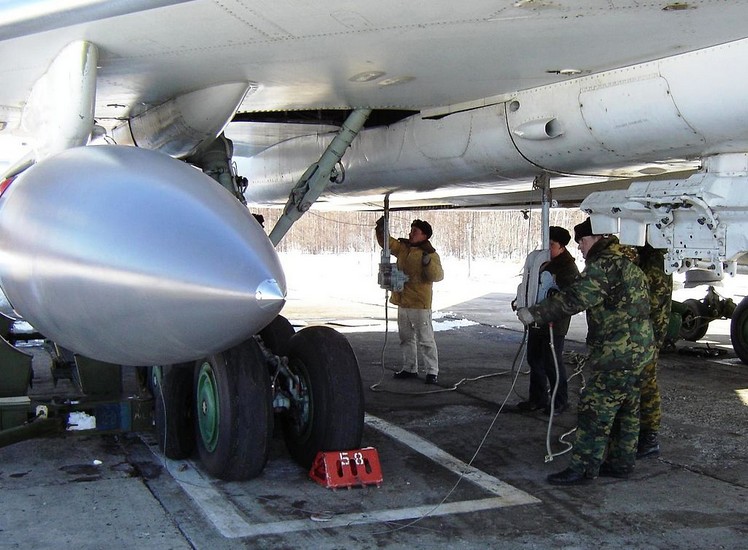
Suspension missile TU-22
combat application
For a long time the Tu-22M were (and are those hitherto) active factor in deterring aggression, because in the first place intended to confrontation with the Navy carrier strike groups in the NATO naval theaters of operations, which would be used for cruise missiles airborne X-22 of various modifications, as well as for violations of maritime communications by setting minefields. Most episodes of conflict in the years “cold war” They are not advertised and are not known to the general public.
For the first time in a real combat situation it was tested Tu-22M2, as a bomber. It happened in 1984 year in Afghanistan, when six crews in 1225 th TBAP attacked the positions of the Mujahideen bombs caliber 9000 kg.
31 October 1988 year combat missions in Afghanistan carried crews of the 185th Guards TBAP on the Tu-22M3 aircraft. enemy positions “treated” bombs caliber 3000 kg. In the same year several carriages 52-th Guards TBAP participated in repelling the attack Afghan militants on the Soviet frontier. The crews of these regiments operated from the airfield Mary.
AT 1993 , six Tu-22M3 840 th TBAP made sorties into sections of the Tajik-Afghan border to repel the attack gangs Tajik Opposition.
FROM 26 November 31 December 1994 , six crews of 840 th TBAP participated in the elimination of illegal armed formations on the territory of the Chechen Republic. Tu-22M3 involved to isolate the battle area and obstacles to approach the besieged rebels in Grozny reinforcements. Aircraft struck at crowded places and ways Dudayevites advancements in the areas of Argun, Gudermes, shawls. With flares OSAB, dropped Tu-22M3, Terrible night illuminated, it was necessary to apply to the Su-24 bombers, precision weapons such as air bombs KAB1500L.
In March 1997 the crew of the same regiments served six missions for the exploration of NATO surface ships in the Black Sea.
At this point, a total of Tu-22M3 committed 172 sortie duration 737 hours and spent 4766 aviabomb plaque 2479 lighting.
During the war in South Ossetia in August 2008 , a group of Tu-22M3 sighting inflicted air strikes on Georgian army ammunition depots, bombed airfields and concentrations of troops in the Kodori Gorge.[20] According to the official version, one Tu-22M3 was shot down as a result of Georgia's air defense systems at an altitude of approximately 6000 m. The plane was piloted by a crew of the 52nd Heavy Bomber Regiment, based in Shaykovka. According to independent analyst Anton Lavrov, leader of a group of Tu-22M3 was shot down while returning from the departure base to bomb the Georgian Infantry Brigade. After this loss, the Russian Air Force until the end of the conflict stopped using long-range aviation.
14 Tu-22M3 were used during the Russian military operation in Syria since 17 November 2015 of the year.
Accidents and Disasters
Altogether during the operation was lost for non-combat reasons 22 aircraft. Besides, among other Russian planes one Tu-22M3 bomber was shot down by anti-aircraft missile Buk-M1 during the armed conflict in South Ossetia 10 August 2008 of the year.
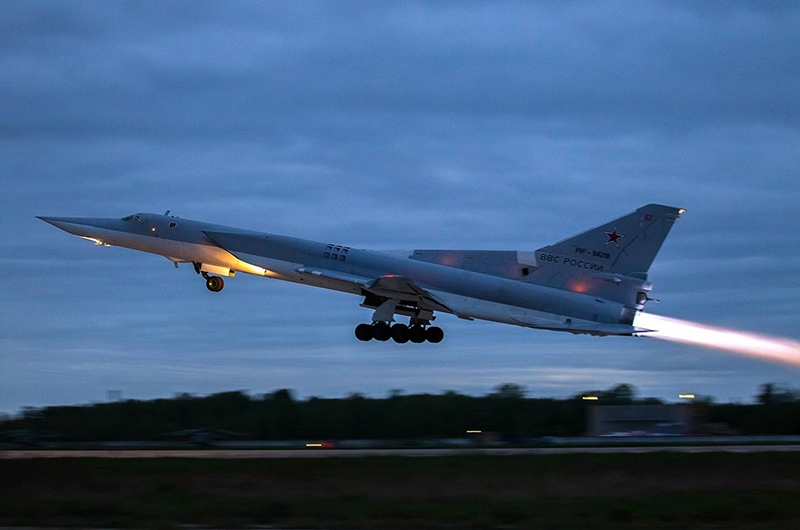
The performance characteristics of the Tu-22M3
The crew of the Tu-22M3
– 4 man
The dimensions of the Tu-22M3
– Wingspan sweep at 20 °: 34,28 m
– Wingspan sweep at 65 °: 23,30 m
– Length: 42,46 m and stabilizer 42,16 on keel;
– fuselage length: 38,5 m
– Height: 11,05 m (11,08 first series)
– Area of wing sweep at 20 °: 183,57 m²
– Area of wing sweep at 65 °: 175,80 m²
Weight Tu-22M3
– Weight of the empty plane: 68 000 kg
– Mass normal takeoff: 112 000 kg
– Weight maximum takeoff: 126 000 kg
– fuel weight: 53 550 kg
Overloading the Tu-22M3
– operation overload: 2,2 g
– limit overload: 2,5 g
Engine Tu-22M3
– engine's type: Turbofan with afterburner
– Model: "NK-25" (article "E")
– engine weight: 2 × 4294 kg
Link Tu-22M3
– maximum besforsazhny mode: 2 × 14 500 kgf
– maximum afterburner: 2 × 25 000 kgf
– idle power: 2 × 800 kgf
Speed Tu-22M3
– Maximum speed at ground 1050 kmh; on high: 2300 kmh
– Cruising speed: 930 kmh
– Take-off speed at a mass 124 t: 370 kmh
– Landing speed at weight 78-88 m: 285-305 km / h
Practical ceiling Tu-22M3
– 13 300 m
Flight range Tu-22M3
– 6800 km
Combat radius Tu-22M3
– the load 12 000 kg:
– at supersonic speed: 1500-1850 km
– at subsonic speed and low maximum altitude: 1500-1650 km
– subsonic on the mixed profile: 2410 km
Takeoff run Tu-22M3
– 2000-2100 m
Thrust-to-weight ratio of the Tu-22M3
– during normal takeoff weight: 0,45 kg / kg
– at maximum takeoff weight: 0,40 kg / kg
Photo Tu-22
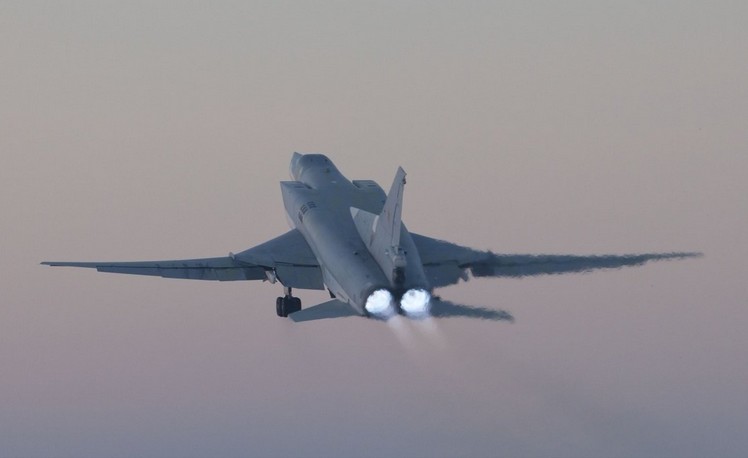
Cabin Tu-22
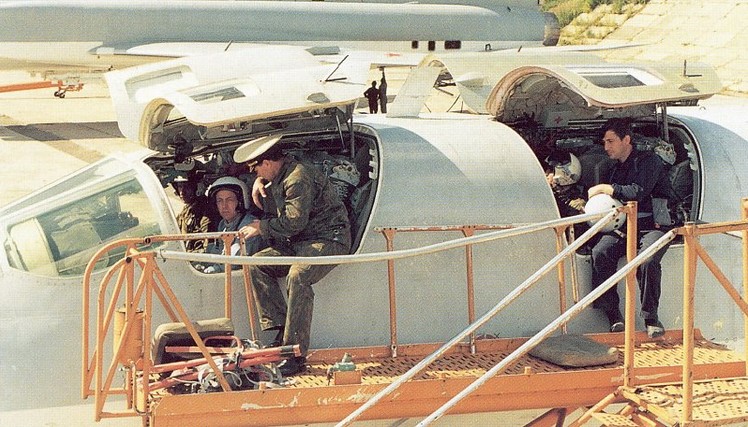
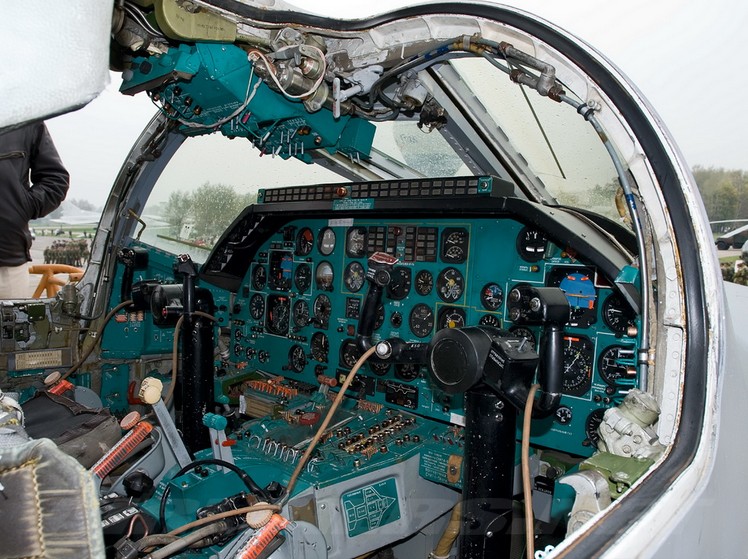
Navigators cabin Tu-22
